#Shinbutsu shūgō
Explore tagged Tumblr posts
Text

A Small Vermilion Shrine for Fudōmyō-Ō, the Immovable Wisdom King ・華寺境内の朱色が美しい不動明王堂
A small vermilion shrine housing a statue of the Buddhist deity Fudōmyō-Ō, or the “Immovable Wisdom King.”
Although located within the grounds of Ryuge-ji, a Buddhist temple, the shrine’s architecture closely resembles that of a traditional Shinto hokora. It’s a quiet example of how Japan’s two spiritual traditions — Buddhism, introduced from China, and indigenous Shinto — once blended naturally in daily life.
This fusion is known as shinbutsu-shūgō (神仏習合), the harmonious coexistence of kami and Buddhas that flourished for centuries. While the Meiji government’s separation order in 1868 sought to divide the two, the effort was not entirely successful. Even today, small moments like this remind us of the enduring ties between them.
Location: Kanazawa Ward, Yokohama, Japan Timestamp: 2025/01/09 17:12 Fujifilm X100V with 5% diffusion filter ISO 320 for 1/480 sec. at ƒ/2.5 Classic Negative film simulation
For a deeper dive, check out sources for further reading and Google Maps links: https://www.pix4japan.com/blog/20250309-fudomyo-o
25 notes
·
View notes
Note
Do you have any more headcanons about the Senju?
Here is a loooooong post with assorted collection of Senju clan HCs for you! They main apply to the Warring States era and early Founders Era. Some of them are new, some I've picked up from some of my older posts.

Disclaimer: This is HC's of the general culture. People are people and won't act in perfect alignment with the norms or social etiquette that is encouraged, may interpret them differently or disagree with them entirely. Hashirama and Konoha also brought drastic change which ended or drastically changed some of these traditions and norms.
CW for a bunch of stuff including but not limited to war, injury, pregnancy, childbirth, sex, abuse, death and more. Reader discretion is advised.
As far as religion goes the Senju lean more into Shinbutsu-shūgō (Syncretism of Shintoism and Buddhism), but a number consider themselves to have little to no attachment to spirituality. Ancestor worship is the most commonly displayed spiritual practice among Senju.
Ashura fought and worked hard for his abilities and gained much from the support of others, and the Senju towards the end of the WS era have managed to breed certain beneficial traits into becoming extremely common within their clan. This includes possessing a genetic anomaly that gives 9/10 Senju a natural affinity for two of the five basic chakra natures, as opposed to just one which is the universal norm (with the exception of a handful of clans with rare kekkei genkai). Another incredibly common trait in Senju was in fact passed on from their ancestor Ashura, which is immense physical strength, stamina and energy (see more notes in next point). Their natural physical strength and muscle density is immense, allowing them to achieve feats that would otherwise be incredibly difficult or impossible to achieve without enhancing your ability with chakra and pushing the natural limits of your body. Stamina can be used to mold into chakra for performing ninjutsu techniques. Having lots of stamina allows them to perform many or stronger techniques while still having energy left to remain physically active. Their strong life-force, which they share with their relatives the Uzumaki, makes them hard to kill. They can be severely injured but still cling to life, even if they may not be able to keep fighting at the time. These traits have allowed them to keep up with the rival and otherwise unmatched Uchiha clan. Their average is what others would consider impressive.
Notes on Physical Energy - The Senju and the Uzumaki Life-force I interpret this as the strength of the bond between the body and the soul. Having strong life-force enables you to stay alive even when your body is put through trauma or illness that can be lethal. It doesn’t mean you are immortal or invulnerable, that you won’t feel the pain or other symtoms of the trauma, or not needing to recover, only that it won’t kill you as easily as it might another. It’s what maintains life within you. Associated with both the Senju and the Uzumaki, but the latter in particular Vitality I interpret this as the energy that drives you to do stuff, to be active. If life-force is the energy that maintains your fundamental state of being alive, vitality is the energy that drives you and makes you feel alive. It’s what allows you to feel healthy and capable and energetic. It’s the energy that gives you the strength and enthusiasm to do things. It is the drive to act, to grow and develop. You could describe a person with lots of vitality as someone who is spirited, passionate, as vigorous, as lively or energetic. The opposite of vitality could be lethargy, sloth or apathy. Associated with both the Senju and the Uzumaki Stamina I can keep doing X activity for Y amount of time at maximum and high intensity before I start to feel tired. It’s about maximizing the energy you put into an activity. Eg. How long can you keep running at the speed you started at before you begin to feel out of breath, your legs burning and feel the need to slow down or take a break? (Can also be applied to mental stamina, but the Yang energy, which is what Ashura’s descendants inherited, is specifically associated with the physical body) Associated with the Senju Resilience Is your physical ability to withstand or adapt and maintain function through changes in circumstances, adversity or difficulties such as illness, injury or other difficult physical demands, and then recover once it has passed. How quickly and effectively you will ‘bounce back’, such as recovering from an injury, or adjust and adapt to the altered circumstance, such as managing an acquired physical disability because of an injury. (Can also be applied to mental resilience, but the Yang energy, which is what Asura’s descendants inherited, is specifically associated with the physical body) Associated with the Uzumaki Physical strength What is sounds like; the force or resistance your muscles are able to exert on physical objects. How much can you lift? How hard can you punch or kick something? If you are being pushed how hard can you push back? This strength manifests in the density of their musculature, which is insane. Not only does their musculature allow them feats of physical strength and endurance, but it also makes their bodies sturdier to an extent; as it supports and protects the integrity and stability of joints and bones. (IRL Muscle density refers to the amount lean muscle tissue in comparison to the amount of fatty tissue in your body. Specifically the amount of fat between the fibres of muscle. Denser muscle with less fat between the fibers allows for increased strength as they can contract more efficiently and with more force. Does not translate to the size or mass of muscles however, or even how 'fit’ you may appear aesthetically. You can have visually large muscle mass but have low muscle density and vise versa.) Associated with the Senju.
They are typically run by primogeniture, where the oldest child, regardless of gender, of the current clan head will by default be raised to become the heir. However, if the current or future clan head displays physical or mental weakness, inability to lead or doesn’t seem to put the best interest of the clan’s current and future welfare and survival before their personal ones, then they can be deposed and replaced by someone the clan deems more fit for the role. So the Senju has no ‘main branch’, although in some cases the line of succession within a specific family has remained unbroken for several generations. As is the case with Hashirama's family.
The Senju is a clan large enough that nobody knows everybody, but small enough that everyone can recognise anyone, and new faces do stick out.
One is typically most familiar with those who are of their generation and age group, as they would have all been trained together from a young age.
The Senju have a tradition of gifting girls and women jade bracelets. A girl will receive her first bracelet by her father when she's young, and might be larger so that she can grow into it, one from both her parents when she comes of age at sixteen, one from her mother the day she gets married, and one from her lover before she marries as a symbol of enduring love, loyalty, and willingness to care for and protect the recipient. The jade bracelet gifted from her lover is the only piece of adornment that tells the world a Senju woman is in a committed relationship. She may also be gifted one by her new father-and mother-in-law when she marries, and another by her husband when she has given birth to a child. Some Senju women only possess one bracelet, while others have many. It is no requirement to always wear them, and some are maybe unable to wear the ones they received as children. Most also remove them for training, assignments or activities where it may be damaged. Others choose to always wear them and rarely, if ever, remove them, and some would have to break it order to get it off. But not wearing it at all regularly was seen as bad luck as the stone was seen as living and needed to be cared for and connected with to obtain the benefits.
It is typical to wear these jade bracelets on ones non-dominant hand, and can be in the form of solid bangles, hinged bangles or beads on a string and tied onto the wrist.
Jade was seen as a symbol of prosperity, success, good fortune and longevity, as well as love, beauty, sincerity, physical strength and health, clarity of mind and purity of spirit. All aspects and traits one would want to attract for the wearer throughout her life. Jade was also heavily associated with the earth, its color and connecting the Senju to their forest.
Jade is also valuable overall so they are precious gifts that can be sold if the woman and her family runs into financial difficulties.
The Senju does allow non-Senju to marry into the clan, but not often and not casually. Still about 20% of all Senju are actually outsiders who were adopted into the clan when they were very young. Adoption is the far more common way for an outsider to be accepted into the Senju. Many of them were not raised to become shinobi the same as any child born a Senju was, though some were, it would depend on the child in question. This has on occasion given the Senju a reputation as child stealing, although these children have usually been orphaned and displaced by the war. Not to say it has never happened that a child was taken in against the wishes of their parents, or snatched from another shinobi clan.
Whenever a non-Senju marries into the clan they are almost always a civilian with no shinobi background.
If you as a Senju did wish to marry within the clan, as a rule choosing anybody that is closer to you than at least five generations removed (i.e. your closest shared ancestor is your great- great- grandparents) will be considered unsuitable and is discouraged, if not straight-up forbidden.
Having shinobi from other shinobi clans marry into theirs is very rare because of the risks it can entail to bring shinobi into the heart of their home. Clans were far too often pitted against each other by employers regardless of any alliances they may have, so it was risky to bring in new members who's loyalty could easily be swayed by sentimental feelings and loyalty for their original clan. Mito was allowed to marry into the clan because the Senju and Uzumaki have historical ties and an overall good to neutral relationship, and because she was the one Hashirama chose so an exception was made.
Respect for your parents and elders is an integral part of social etiquette. Seniority can trump rank. A younger member with a high rank is still expected to respect and take into account an older member's input and experience. The parents of a child are responsible for teaching their children about this etiquette, as a child being disrespectful towards an elder, be they a sibling, parent, distant relative or otherwise, will shine a bad light on their family. Hashirama’s public and loud display of anger towards Butsuma during Kawarama’s funeral broke both the etiquette of respecting your elders and parents, and respecting the dead.
Teamwork and comradery is highly encouraged and the Senju are known for their efficiency when working in squads of five to ten individuals. Their tactics and ability to quickly regroup and adapt to a situation as a unit is drilled into them from a young age. Some of these tactics have been specifically formed to deal with Uchiha who have the sharingan, exploiting the weaknesses of the dojutsu such as blind spots and any disproportion between the sharingan taking in information and the body being able to act upon it. Though some find them predictable because of this, it's nonetheless acknowledged that they are highly efficient and dangerous when they are working together, which is why opponents may attempt to divide the group. (Also one of the reasons why I believe the Senju died out. They had thrived on their methods during the WS era but were uprooted by the new mixed team system and became weaker for it, dying more frequently in combat.)
As the Senju put a lot of emphasis on camaraderie, they promote relationships of trust and devotion between peers over strictly familial or filial ones. Treat and love all your peers as your brothers and sisters. Get along, be respectful of each other, and stay close. Love and support each other for life.
You are considered an adult by the age of 16, at which point you can attend clan meetings get a say in how the clan is being run. At this time making it to 16 boosted your chances of living to 40 to about 80%. (Before the years of the plague around 790CE, about 200 years before Hashirama, which resulted in what was necessity and desperation turned into a tradition of deploying children as young as 6 and 7 into war, those under 13 would rarely be given missions, much less be a part of open combat. If they were brought into the field, their involvement in actual combat was minimal at most, and instead served to help out at the campsites, help care for wounded and such things.They were still trained hard from early childhood, and were expected to be fit for combat by fifteen at the latest, but by then most would have been able to form enough strength and ability to actually keep up reasonably well with the adults. But once Hashirama became clan head he pushed for strictly refusing anyone under 15 to be given missions, and nobody under 16 was to be made to participate in war campaigns and had to go through an evaluation of their skills before being allowed to do so.)
You are considered eligible for marriage by 18 for boys, and 20 for girls.
Having children before that point is absolutely not encouraged. The desire was for one's body to be fully developed, strong and healthy before you decide to have a child, regardless if you are the one who will be pregnant or the one who impregnates. The average age for having your first child was somewhere between 20 and 25 for women.
Menstruation and contraceptives HC
The Senju does not practice polygamy or concubinage, and having children outside of marriage is discouraged as it makes keeping track of who is related to who far more difficult.
A woman could have children without being married or even have the father involved in her life at all, and it wasn't considered bad as much as impractical, but it would be expected of her to still know who the father was so that the child's lineage could be accurately recorded for future reference. In these cases the children would be recorded as members of the bloodline she was born into, but still with a note of their paternal ancestry.
Contraceptives and abortifacients were considered incredibly common medicines and widely used by the Senju so unexpected or unwanted pregnancies carried to term were rare. Procreation however is your duty to the clan, and there is a general expectation and pressure that all members should sire and raise at least one child in their life, and becoming a parent would boost one's social standing within the clan a bit.
It was considered more acceptable for a woman to have several children by different fathers, than it was for a man to have several children by different mothers. Again it comes back to maintaining the bloodlines. Just one man somehow persuading multiple women even in a short amount of time to have his children could spell a great deal of trouble down the line, if there were too many half-siblings catching an interest for each other. A Senju displaying behavior like this and carelessly undermining the lasting well being of the entire clan for his own gratification could end up being severely reprimanded, as in have his ability to ever have any more children removed. Permanently.
Marriage traditions are overall practical and uncomplicated. Very rarely a grand affair and was typically small and intimate. At it's most basic the couple more or less just has to state they take each other to be their respective partner in marriage, in front of a witness, and it's considered legitimate once the couple has been noted in what can be described as a family registry. Having a small celebration with close friends and immediate family is not unusual though.
There is a lingering tradition of asking for the father's permission to marry a daughter, but more often than not the prospective couple have already entertained a relationship for a while, and frankly asking for permission is just a curtesy and display of respect. If the family dissaproves then elopements are common. And the clan overall usually don't care much for such drama, unless one of the pair is a non-Senju or is a Senju but turns out to be too closely related to the other. If it's the latter case, then the pair's marriage will be considered void and they will not be allowed to live together, and that however can create some significant drama.
While procreation is is very much promoted as a duty and necessity for the clan's future, sex is also seen by the Senju as entertainment and socialization, and something to be enjoyed between equals, regardless if it's between casual lovers seeking a moment of escapism during a campaign, or a married couple in their shared home. Known for their open hearted and casual view on the topic which some find uninhibited and offensive. Although no self-respecting Senju would be caught dead in a brothel or ever dream of paying somebody for sex, they are often known to be unabashed flirts, both towards other Senju and outsiders, and to outsiders they would seem to not strictly limit themselves to their marital partner, and premarital, relational, recreational and casual sex is normal. Some non-Senju find this alluring and enticing, others are appalled and see this behavior as licentious and inappropriate.
The Senju however often also think other clans are too stiff and restricted in the way they are allowed physical expressions of love, sexual fulfillment and even just platonic affection. Life is way too short for that.
While polygamy was not accepted within the Senju, polyamory was generally fine, and both men and women could have consensual extramarital relationships and lovers and most would look the other way. As long as it was done discreetly and with one's marital partner's consent to such an arrangement, without humiliating them by publicly favoring their lover, and you still respected, honored and performed your role as a husband/wife or father/mother. Having at least one child with one's spouse was also generally a requirement for others to be accepting of a couple seeking any emotional or physical fulfillment or other connection that could not be found within their marriage. And again. Having children outside of one's marriage was strongly discouraged for bloodline and record reasons.
While polyamory, sexual and romantic relationships outside of marriage weren't necessarily frowned upon, and one was overall expected to be discreet, attempting to actively hide and deny the existence of these relationships very much was. It signaled shame for what they were doing and likely was doing something that was not a part of the agreement between them and their partner, and was seen as manipulating and betraying the mutual trust and respect between a married couple.
Divorce was a possibility, but rare. If one partner started favoring their extramarital lovers and relationships over their marital and familial ones, or mistreated their family, then the other partner or even their relatives could bring up the issue and demand a separation. Although during the era of warring states, a marriage usually didn't last long enough for a divorce to come up as a necessity, as one or both of the pair were likely to die in the line of duty fairly young. When that happened, it was not at all uncommon, encouraged in fact, for the surviving partner to remarry if they so wished.
The “Will of Fire” before Hashirama came along was a philosophy of the Senju, but it was different. It centered the current and future prosperity of the clan and the bonds you had with others within it and it alone, for your family and friends, not a village. A Senju during the WS era and early founders era would speak of the Will of Fire and in doing such mean something song these lines: “Fight for each day, never relent but if you believe you are going to die ensure you don’t go down without a fight.” “I will stay alive for the prosperity of my clan, I will fight to let all those I love thrive for one more day, but if I have to die in the process of securing their future I will take my enemies down with me.” “Fight to stay alive for the future of your clan, let that drive burn within you…but if you see the end ahead of you, make sure you let your enemies burn down with you.”
Speaking ill of or disrespecting the memory, resting-place or places for memorial of the dead is deeply frowned upon
Disciplinary action can be physical and very unpleasant depending on the offence.
'Tough Love' is the dominating norm, and coddling children too much is considered deeply detrimental to their future.
Honor your clan. Wear your crest with pride and dignity. When you wear your clan's crest, you represent it, so never act in a way that will bring shame upon it and all others who wear it, have worn it and will wear it in the future.
Life is fleeting and impermanent, and death is an inevitable part of life. Everything ends one way or another. Accept this irrefutable truth. Train hard, and fight with discipline and vigor and with the anticipation of death, and seize and enjoy the time between. Celebrate the things you fight for, love deeply, and find pleasure in the simple things when you can.
Don't speak without thinking, and speak only when you have something worth saying. Senju can be considered blunt, but overall sincere.
Do not waste food or drink. If you really do not wish to eat or drink what you are offered for some reason, accept it politely but leave it without eating or drinking it. Food was frequently scarce during the WS era, so refusing food was not only impolite but also just plain wasteful.
Maintain good hygiene. When in the field, take all opportunities that are offered to wash up. Keep your clothing and equipment clean, neat and maintained as well. Treat your belongings well, or they might fail you when you need them, and they may not be easy to replace. Treating your belongings poorly or having a dishevelled appearance can not only be cause of disapproving looks, but even disciplinary action. You represent the Senju and a higher class of professional soldiers, you should look and act the part.
Variations of games such as capture the flag, dodgeball, episkyros and tag are a common part of training in order to promote dexterity, teamwork, strategic thinking, perception and taking swift decisive action based on the circumstances.
Some acts of disobedience are more acceptable than others, and it is usually rather a matter of if you get caught doing it. For example, if you get caught sneaking out of the house at night you'll get scolded or disciplined for being caught, rather than the act of trying to sneak out itself.
Shinobi children often had many siblings, and parents that could be away from the home for extended periods of time or die suddenly, so being able to help care for their family by performing domestic and household tasks and being self-sufficient was important regardless of gender. This responsibility particularly falls onto the oldest child, but everyone is expected to pull their weight when needed and however they are able. The parents or closest living adult relative are the ones expected to make sure their children gain these skills.
A shinobi will have to do and endure terrible things, you are expected to be relentless, cold, and uncompromising in battle, but you should always separate who you must be on the battlefield from from the one you are at home. You have to learn this. If you get consumed by anger or pain or grief and can't function off the battlefield, or start engaging in antisocial behaviour and needless cruelty towards fellow Senju, civilians or even enemies in some cases, you are a burden to the rest of the clan.
It is alright to grieve, but you should not let it, or any other emotion for that matter, consume you. That makes you a problem. Don't be a problem.
Treat guests with respect and hospitality. Although the Senju rarely bring outsiders into their settlement, they are excellent hosts when they do. And once the village was founded and you visited a Senju household, you would always be offered to at least sit down and have some tea before you left.
If possible the Senju prefer to bury their dead respectfully in coffins, but are also frequently known to also burn them if they can't bring the remains with them to be buried. In those cases a portion of the ashes are typically retrieved to be buried or spread elsewhere. Worst case the remains will be left where they have fallen if circumstances makes them unrecoverable. Sadly that is an all too common reality. Regardless of how or if they were given a proper burial or sendoff, the dead are primarily honored at household shrines and in memory groves.
There are a two memory groves in the Senju's forest, several centuries old but the clan does its best to maintain them, because they are very important to them. They are essentially parts of the forest that has become places for honoring and remembering the dead. After the remains of fallen members of the clan who couldn't be retrieved and buried properly are burned, a portion of the ashes will be gathered and brought back home then buried or spread in these groves. But those who's remains couldn't be found or retrieved, buried or burned at all are also given space for remembrance. There are no headstones or markers, but like the rest of the forest there are statues of Jizo and the Buddha, as well as shrine-like formations set up where lanterns can be lit, incense, offerings, and such can be placed. The Senju visits these mossy groves to remember and honor their fallen friends, family and ancestors, named and unnamed, to pray and to meditate in the quiet and peaceful setting.
When you visits it is customary to treat the grove with care and respect, to keep the space cleared of branches that may have fallen from the trees, perhaps take the time to clean the statues and shrine, remove wilted flowers, burned out incense and offerings worn out by the elements. Children are frequently brought to the groves and allowed to help keep them maintained and to gain an appreciation for the significance of the sacred space. Food offerings are not left in these groves as it attracts wildlife, so such offerings are typically left at a household shrine.
During Obon these groves gets extra attention and visitation.
Because of their habit of adopting outsiders into the clan, the physical appearance of the Senju can vary greatly and the clan has seen everything from very dark skin to very fair, from black hair to white, and everything in between such as hues of red, brown and golden blonde, including rarities such as light blue, purple and green. Though brown hair and dark eyes are the dominating features.
The birth of a child is a momentous occasion that will be celebrated more than most others. It is one of the occasions where the father of the unborn child (assuming he's alive and that the mother wants him there) is expected to drop everything and be present for the birth and any siblings will be called home. The father of an expectant mother in the late stages of pregnancy will usually not be given assignments that he can't easily return home from, and if he still knowingly accepts such an assignment it may make him look bad. The father will be present during the birth to support the mother and will be expected to help if he's needed, but a midwife or an experienced mother or other trusted female relative or friend will be the primary attendants of the birth.
After the birth, the placenta will be wrapped in cloth and buried, returned to nature, by the father and any siblings of the newborn.
It is typical that the child's name won't be shared until it is a week old, at which point available friends and family will celebrate the strength, efforts and continued health of the mother and the new addition to the family and the clan with gifts, talismans and blessings. But from the moment the baby draws breath, it should not be touched by anyone other than the mother, father, it's siblings and the midwife who delivered it for a month, as to make sure it is strong enough to not catch any illnesses.
While giving new clothes to a couple for their wedding day is considered optional, and is usually skipped in favor or simply thoroughly washing and mending their best garments to wear, it was definitely encouraged and seen as auspicious to gift new blankets, swaddles, bedding, and clothing to a newborn.
Although life expectancy was short and that it was rarely easy or kind to shinobi, it did not stop people from celebrating and hoping for the child to live a long, happy and prosperous life.
During that first week the family would be given time of solitude and bonding, and the mother should be allowed to rest. She may walk around if she's feeling ready for it, but she should refrain from doing much else than caring for herself, her needs and those of her new baby.
While the mother recovers from the birth and tends to the infant, the father will get all the responsibility to look after her and the rest of their family by doing household chores, making sure the mother is fed hearty and nutritious food so that she may regain her strength, that she gets opportunities to bathe, he'll look after their other children, and so on. While others are meant to offer space and quiet to the family, close relatives like the parents of the mother and father or their siblings may visit to offer support and help with these tasks, or be there in the place of the father if he's for some reason not in the picture, but if he is he's the one expected to be there for the mother and their family at this important time. Shrinking away from this very important responsibility paints him in a bad light which can be cause for separation and affect his social standing within the clan. The long, laborious and dangerous but invaluable undertaking of carrying and birthing a child into world, to the clan, should be treated with nothing less than respect, support and celebration.
Unless circumstances demand otherwise, the mother will remain at home with the infant for at least two months before she's expected to return to her duties as shinobi. She's typically not expected to take on assignments that takes her away from the infant for extended periods before the child is at least 18 months or so old. The time between a mother's later stages of pregnancy, the first few months and two or so years of the new child's life would likely be the longest mostly uninterrupted time she would get to spend at her home with her children, before missions and campaigns would keep her away from them for sporadic and often extended periods. The case was worse for fathers. Sadly this could create distance and tension between the children and the parents if efforts weren't made to stay in touch and really treasure the time they did have with them. Which usually wasn't easy.
As the child grows older and less dependent on the mother, other family-members such a grandparents, aunts and uncles, cousins, older siblings, neighbours and family friends and so on will help in looking after each other when the parents were not around. As mentioned previously, if none of the parents were around and no other senior family members were present, then the oldest sibling held responsibility for the younger ones.
If the child was a girl, she will typically receive her first jade bracelet between the age of 3-7. Usually just a simple cord with beads. Once she comes of age at 16 she is traditionally given a full bangle if her family can afford it. Before she marries her potential partner is expected to be able to pay for another full bangle.
#;;ooc#;;headcanons#v; warring states#v; main#;;brain storming#;;answered#;;anonymous#;;senju#senju clan#senju clan headcanons
11 notes
·
View notes
Text
Shinto: The Way of the Gods

Shinto, the indigenous religion of Japan, is an ancient spiritual tradition deeply woven into the cultural and historical fabric of the country. Unlike many major world religions, Shinto lacks a singular sacred text, a centralized religious authority, or a strict doctrine. Instead, it is a belief system centered around nature worship, ancestral reverence, and a deep respect for kami--divine spirits or deities. The word "Shinto" itself, derived from the Chinese characters "shin" (god, spirit) and "tō" (way, path), translates to "The Way of the Gods."
The Origins and Evolution of Shinto
Shinto's origins can be traced back to Japan's prehistory, emerging organically from the animistic beliefs and rituals practiced by early Japanese communities. Before Buddhism and Confucianism arrived from China and Korea, Shinto formed the spiritual backbone of Japanese society, emphasizing harmony between humans, nature, and the spiritual realm.
During the 6th century CE, Buddhism began to take root in Japan, leading to a period of syncretism in which Shinto and Buddhist beliefs coexisted and even intertwined. Many Shinto deities (kami) were identified with Buddhist bodhisattvas, and Buddhist temples were often built alongside Shinto shrines. This fusion, known as Shinbutsu-shūgō, persisted for centuries until the Meiji Restoration in 1868, when the Japanese government sought to separate Shinto from Buddhism and establish it as the state religion. This era of State Shinto lasted until the end of World War II, when Japan's post-war constitution formally declared the separation of religion and state.
Core Beliefs and Practices
At the heart of Shinto is the concept of kami, which are divine spirits believed to inhabit all things, including natural elements like mountains, rivers, trees, and even human ancestors. Kami are not omnipotent or distant gods; rather, they exist in close harmony with the world and interact with humans in various ways. Some kami are associated with specific locations, while others represent virtues, emotions, or historical figures who have been deified.
Shinto practitioners engage in various rituals to honor the kami and maintain purity, both physical and spiritual. These include purification rites (misogi), prayers (norito), and offerings (shinsen) at Shinto shrines. Seasonal festivals (matsuri) are also an integral part of Shinto worship, celebrating nature's cycles, agricultural prosperity, and significant historical events.
Shrines, known as jinja, serve as the sacred spaces where people connect with the kami. Each shrine is typically marked by a torii gate, symbolizing the transition from the mundane world to the divine. Within the shrine grounds, visitors purify themselves by washing their hands and mouth at a temizuya (water basin) before offering prayers and making small offerings.
Shinto and Japanese Culture
Shinto is deeply embedded in Japanese culture and influences many aspects of daily life, art, literature, and traditions. Many of Japan's most famous festivals, such as the Gion Matsuri in Kyoto and the Kanda Matsuri in Tokyo, have their roots in Shinto rituals.
The ethical framework of Shinto is not based on commandments or moral absolutes but rather on virtues such as sincerity (makoto), harmony (wa), and respect for nature. These values have shaped Japan's social structures, aesthetic sensibilities, and even martial traditions like bushido, the samurai code of honor.
Shinto also plays a role in major life events. Many Japanese people visit shrines for blessings on New Year's Day (hatsumōde), celebrate coming-of-age ceremonies (seijin-shiki) at Shinto shrines, and partake in Shinto-style weddings. Even though many Japanese do not actively practice Shinto as a formal religion, its customs and rituals remain an integral part of their lives.
Shinto in the Modern World
In contemporary Japan, Shinto coexists alongside other belief systems, including Buddhism, Christianity, and secularism. Despite Japan's rapid modernization and technological advancements, Shinto continues to thrive, particularly through shrine visits, traditional festivals, and cultural practices.
Environmental awareness and sustainability have also sparked renewed interest in Shinto's reverence for nature. Some environmentalists draw inspiration from Shinto's emphasis on living in harmony with the natural world, advocating for conservation efforts and sustainable living through the lens of spiritual and cultural preservation.
Outside Japan, Shinto has gained recognition through popular culture, especially in anime, film, and literature. Movies like Studio Ghibli's Spirited Away and Princess Mononoke depict Shinto themes of nature worship, kami, and the struggle between human progress and environmental balance. Additionally, Shinto's aesthetics, including torii gates and shrine architecture, have become iconic symbols recognized worldwide.
Conclusion
Shinto is more than just a religion; it is a living tradition that continues to shape Japan's identity, customs, and values. Its emphasis on nature, purity, and harmony offers a unique perspective on spirituality that remains relevant in today's world. Whether through grand festivals, quiet shrine visits, or simple acts of respect for nature, Shinto remains a vital force in Japanese culture, bridging the past and the present in a seamless, sacred way. As the Way of the Gods, Shinto offers a path not of rigid dogma, but of reverence, connection, and an appreciation of the divine in the everyday world.
3 notes
·
View notes
Note
Hello!
I am studying Buddhism and Shintō and I was wondering how people combine these two worldviews in Shinbutsu-Shūgō? As I know Shinto is very focused on nature and love for the world around us, while Buddhism believes that we are in the wheel of samsara, the world is full of suffering and we should leave here to Nirvana
Thank You in advance for Your answer.
I don't think Buddhism encourages leaving this world in any way, but rather teaches us how to deal with hardships, trauma, and inequality in this life. It's understandable why many people think Buddhism is more afterlife-oriented, especially in Japan, but this definitely does not mean that this world is inherently bad. It's more of a neutral perspective, from what I've read and heard. Both Shintō and Buddhism acknowledge that the natural world can harm, and the ways this is explained, as well as how humans react to it, varies by sect.
I think Zen temples are a good example of how Buddhism can focus on nature (though I'm not Zen, so please don't take my word for this!). There's a reason why monks trained in nature, in mountains far from the city. There's also a reason why even today, Shugendō practitioners keep practicing their asceticism in the wild. Reminding ourselves that we are part of nature is still Buddhist; being a good steward for nature is probably a way to build good karma (toku) which you can dedicate to others. To give a concrete example, I see veterinarians and those involved in animal welfare and rescue as being of service to Kannon-sama, because that is a field in which compassion is a driving force. Not that you have to be Buddhist to be a veterinarian, but I believe it to be a profession that is inherently compatible with Kannon-sama's goals. Of course, this includes wildlife rehabilitation, and I'd say is even more relevant for 'uncharismatic' wildlife such as vultures, who play a valuable part in the cycle of life on this planet. I lack knowledge in the field of plants, but I'm sure there is something similar to be said about people who engage in environmental activism, guerilla gardening, etc.
Shintō isn't necessarily about love for the world around us, but appreciating connections between people, kamisama and so on, spanning from history to now: the ancient peoples who discovered rice could be edible, to those who first farmed with it, to the farmers currently harvesting it, to the rice itself, full of life, on your plate.
Thank you for sending me this question, it really got me thinking!
14 notes
·
View notes
Text
yamagata (part one)
So last October, my father and I rented a car and drove around Yamagata, Japan. We were there mostly because I'm a terrible little nerd and I really wanted to see the Dewa Sanzan, but we also stayed the night in an onsen town in the middle of a volcanic caldera.
The trip didn't go entirely to plan... I meant to have three days so we could more thoroughly explore the sacred mountains, but it ended up storming terribly for a couple days, so hiking... Not ideal...
I have mobility issues (and Dad was recovering from an injury) so I have to be pretty careful while doing stairs in the first place, so... doing it during a storm... It just wasn't going to happen. Still, though! We got to see a lot of cool things and we had a nice time.
Explanations and photos under the cut!
To begin with, the Dewa Sanzan are a set of three extremely sacred mountains in Yamagata Prefecture. The three mountains are Hagurosan, Gassan, and Yudonosan. That's also the order in which they're meant to be hiked, and each mountain increases in sacrality.
Which religion are they sacred to? Well... that's kind of a complicated question. When Buddhism came to Japan in the 6th century, it entered into a sort of (sometimes awkward) alliance with Shinto, the indigenous religion of Japan. (...more or less...)
You hear the term shinbutsu shūgō a lot around the mountains of Yamagata. Basically speaking, this refers to the syncretic religion created by combining elements of Shinto and Buddhism. There's another concept, honji suijaku, which explains how this was accomplished. The idea is that Buddhist deities were manifesting themselves on earth as Japanese kami, or the indigenous spirits that made up Shinto. In other words, the idea was that when Japanese people were seeing kami, they were actually seeing Buddhist deities who were disguising themselves in order to better spread the precepts of Buddhism.
These syncretic kami-buddha(/bodhisattva) pairs were called gongen. This part's important for where I'm going next.
This syncretic religion wasn't really cohesive or regulated throughout Japan. There wasn't one set list of sacred texts or one set person in charge to make rules, y'know? It spread around Japan largely organically, so there was a lot of variation in belief systems, rituals, etc. Some people would identify more with the Shinto side of things, some more with the Buddhist side.
What I was interested in, and why I went all the way out there, was a mountain ascetic religion called shugendō. Shugendō was a religion primarily practiced in the remote mountains of Japan, and it centered largely around the worship of gongen as well as submersing oneself in nature to meditate. It wasn't exactly easy to learn about where I went to school in Kyoto, so I jumped at the chance to rent a car and go see some mountains that were very sacred to shugendō practitioners, or yamabushi.
(I had originally also had us going to see the Kumano shrines in Wakayama, but after Dad got hurt, I cut a lot of walking out of the trip. So we chose Yamagata because you could drive right up to a lot of the shrines.)
Now, during the Meiji period, Shinto and Buddhism were forcibly separated by the government. (I won't get into the whys right now.) When that happened, a lot of syncretic sites were forced to either choose to be one or the other or be physically destroyed by the government. On Dewa Sanzan, most of the shugendō sites decided to convert to Shinto. It makes it kind of odd, when you're walking around a Shinto shrine that still clearly, clearly has a lot of Buddhist influence...
One of my big interests, when it comes to religious studies, is syncretic religions, so I've been wanting to learn more about all this for ages. But, due to the purposeful destruction of religious orders/sites as well as the remote locations... well, it's been hard. I was PUMPED to get out there.
lmao now that I've given you all a mini history lecture...
Yamagata!
Now, the first day, Dad and I rented a car in Yamagata City and drove out to Hijiori Onsen. It was really out in the middle of nowhere and honestly? Big Spirited Away vibes. I'm over here explaining the concept of kamikakushi to Dad and he is like. Not loving it.
Add to that the fact that it was raining and dreary and kind of awful, and the whole situation was just spooky.
Hijiori Onsen is also known for something in particular -- a thing that I forgot to tell dad about. They're known for making kokeshi dolls, which I guess explained.... uh. what we encountered on the drive up.
Oh? What's that in the distance?
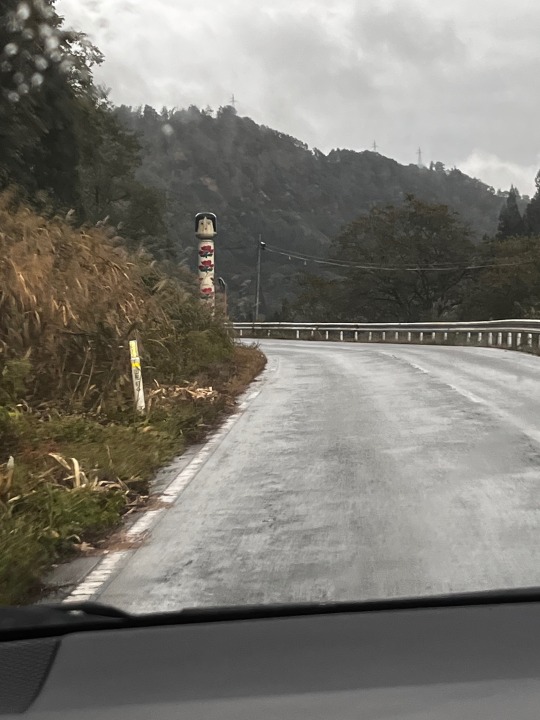
A giant, deeply creepy kokeshi?
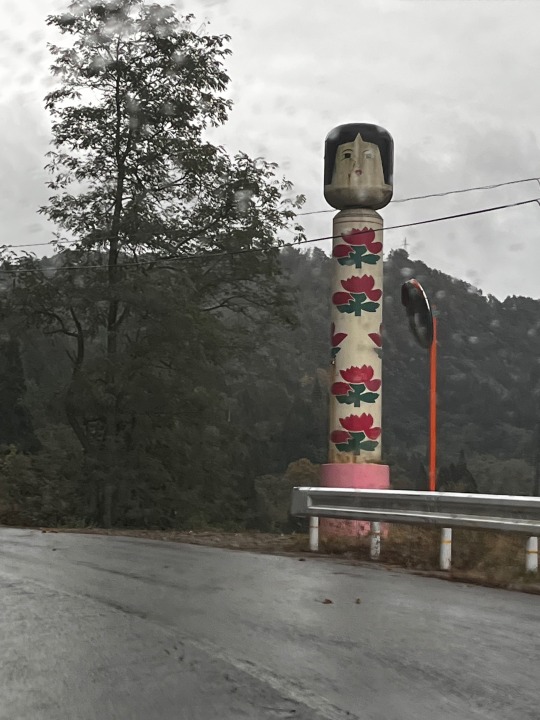
The terrible weather and empty countryside really did not make these things more reassuring.
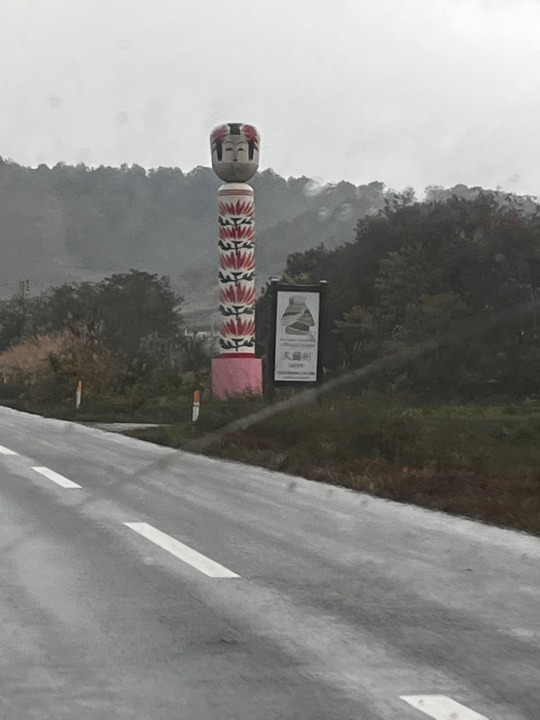
I will be honest with you, the whole area kind of had Fatal Frame vibes lmao.
BUT when we finally made it to Hijiori Onsen, it was really lovely.
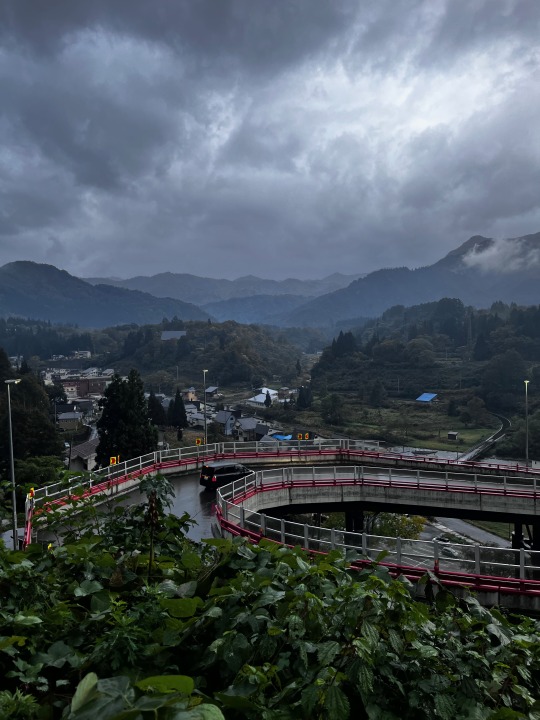
This was our ryokan, aka the only one that had an elevator and would allow my father's tattoos lmao.
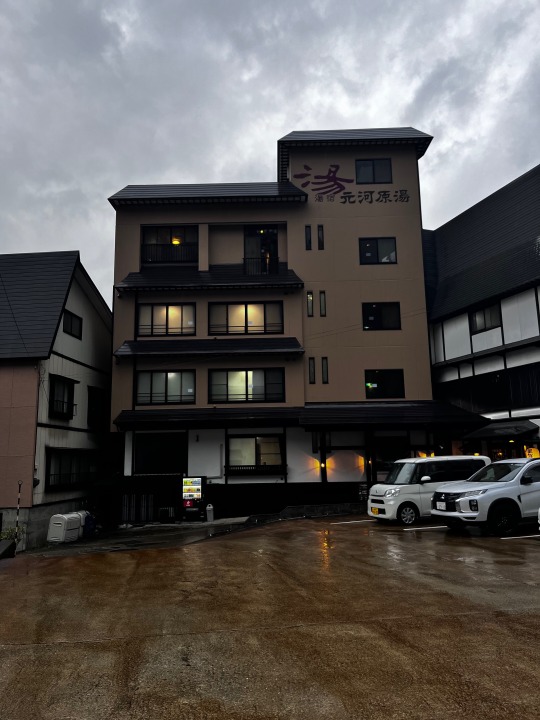
And oh look, more kokeshi. lmao
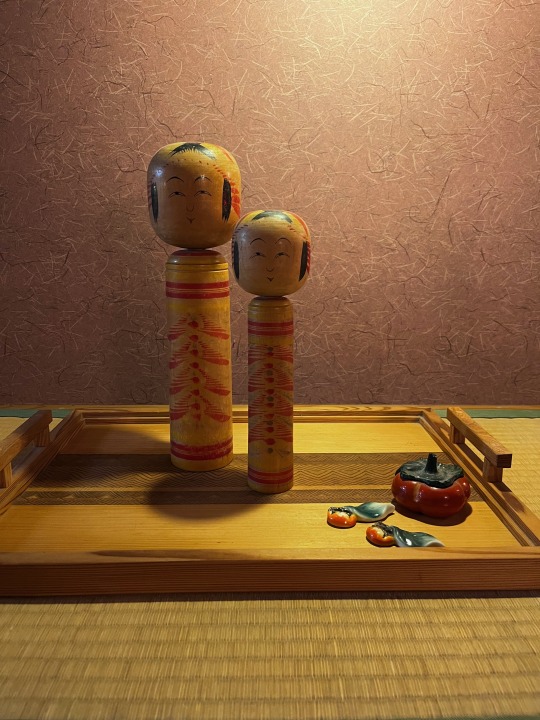
It was kind of fun to see the traditional fall decorations (the persimmons) next to more modern Halloween ones.
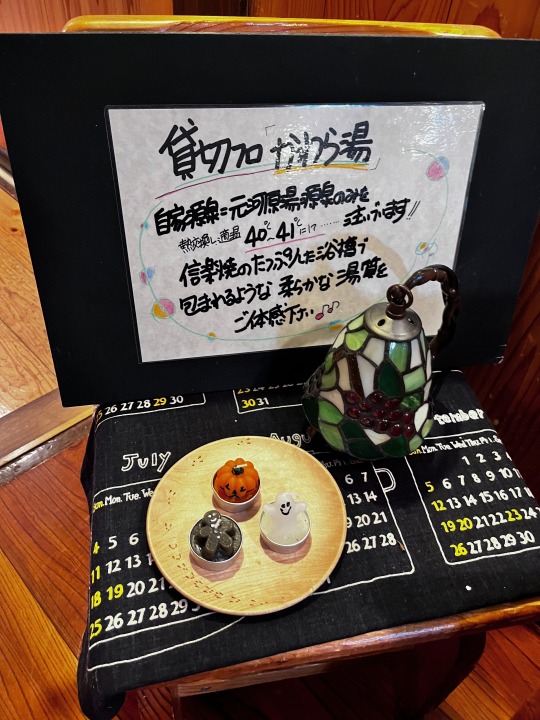
It was really lovely inside, though, and this was the view from our room.

They also had a lot of local snacks, which was fun to try. (Pictured: apple cookies, green tea, and... I want to say candied burdock root?)
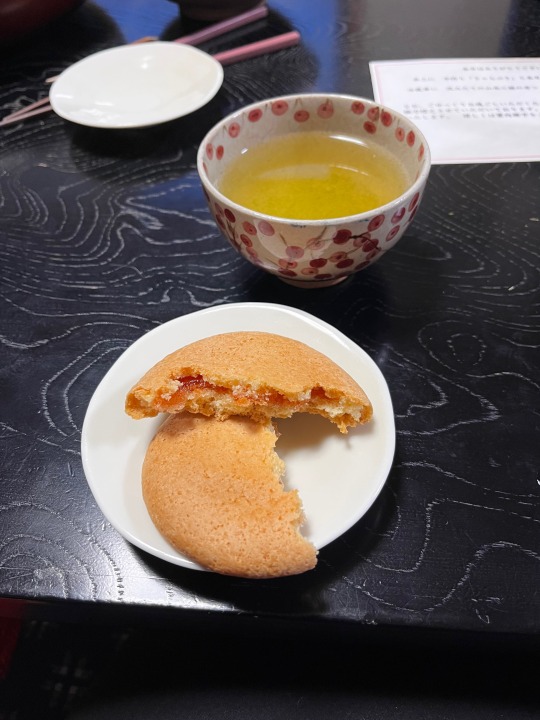
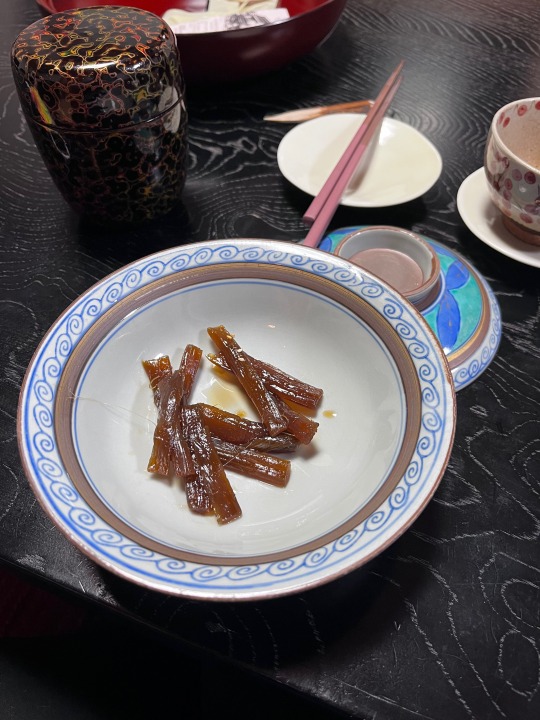
The food was a recurring theme, tbh. They fed us so much that my Dad was like no ;; please ;; we'll die ;;
More kokeshi, this time in the form of a chopsticks rest.
(Yes, I did buy myself one of their kokeshi at a shop in town before we left, lmao.)
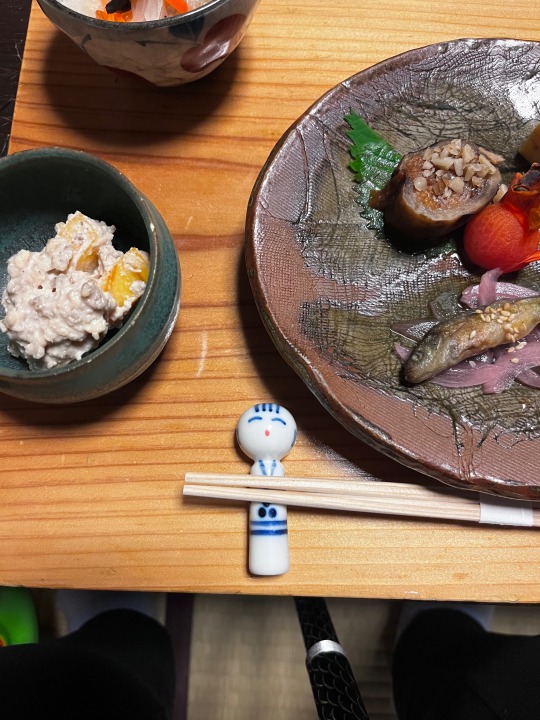
The dining room was pretty, with traditional braziers, soy sauce jars, etc.
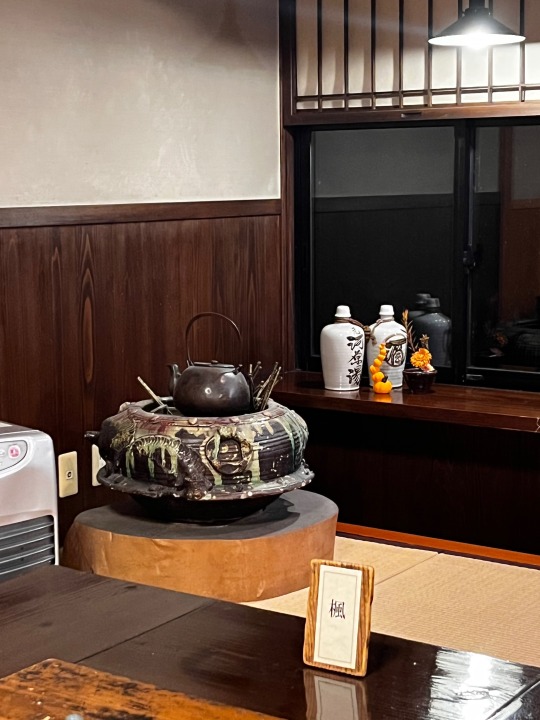
Seriously, though, dinner lasted for like two hours and they must have brought dozens of little dishes.
They cooked the local beef and vegetables inside giant leaves, which was fun and tasted really nice. Kiritanpo rice balls... Sesame-crusted fish...
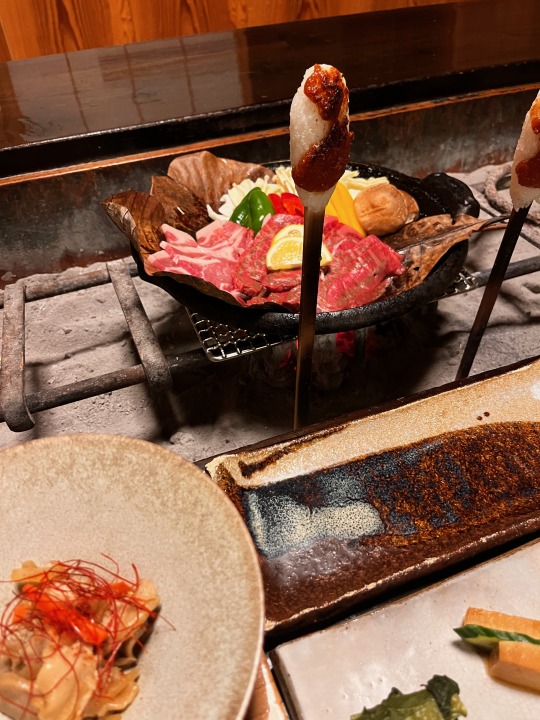

Even things I wasn't expecting to like as much, like the horse sashimi (🥲) and the fried fish bones were pretty good. (Honestly, horse is a little flavorless for me, but the fish bones were surprisingly good.)
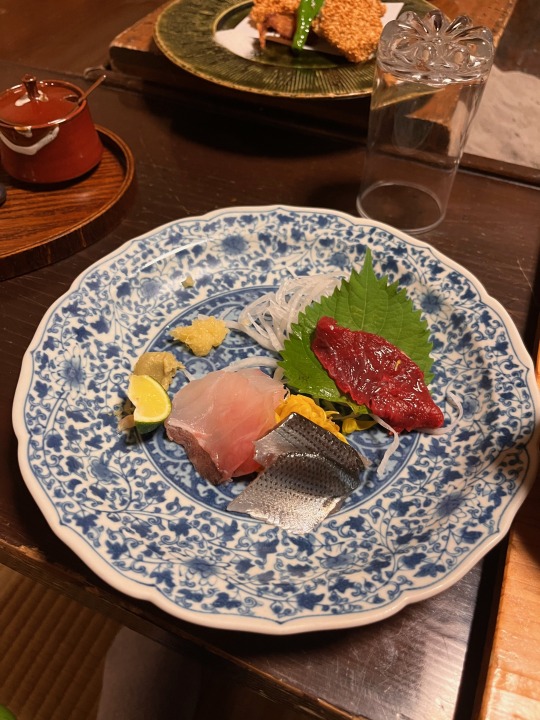
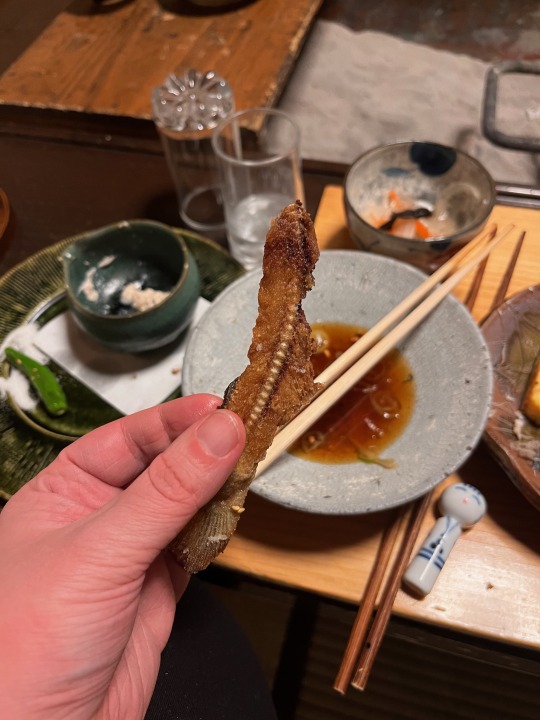
I won't show photos of everything (we'd be here all day) but one more highlight of dinner was the imoni, which is a sort of beef and taro hotpot they make in Yamagata in the fall. It was so good. ;; Tasted like sweet gyuudon with potatoes.
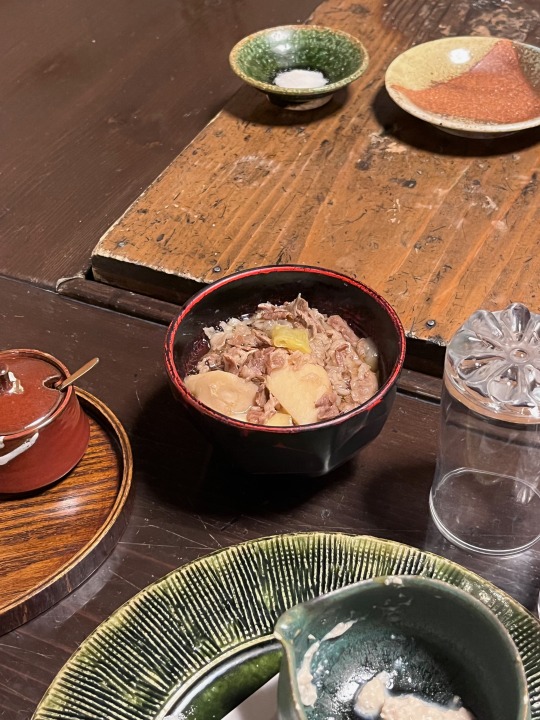
Also, I don't believe I got a photo of it, but when they were like "we have pumpkin :) :) for dessert :) :) happy halloween, americans!!!" I was like "omg, kabocha is my favorite, especially pudding!" and he was so excited, he was like YES, WE HAVE KABOCHA PUDDING! It was really cute.
(They seemed equally shocked and thrilled by my not-great Japanese. lmao. I think they'd had very low expectations of the weird Americans who'd come all the way out to Yamagata for reasons unknown to them.)
And after dinner, they brought a selection of local sake to my room to let me try, including some nigori sake, which is my favorite. It was so nice, even if we almost died from the sheer amount of food. They just kept BRINGING it lmao.
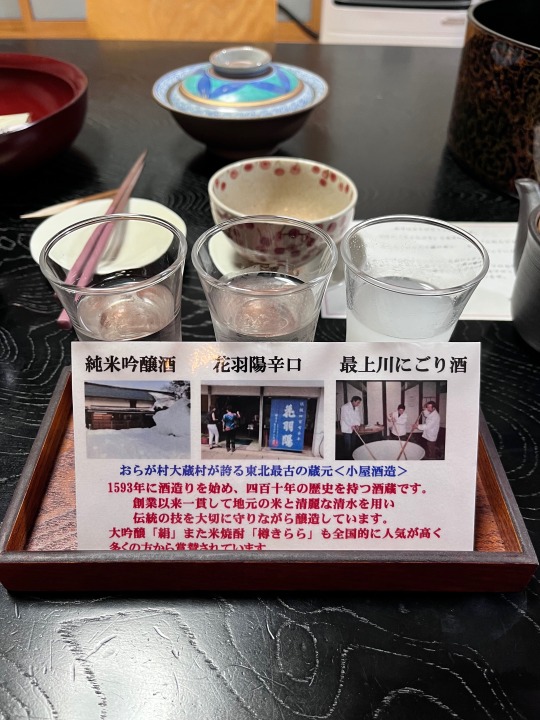
The baths there were also really nice, though obviously I couldn't take photos of those.
And this was the view from my window the next morning, once it was light out:

And breakfast, which was again far, far too much food. lmao
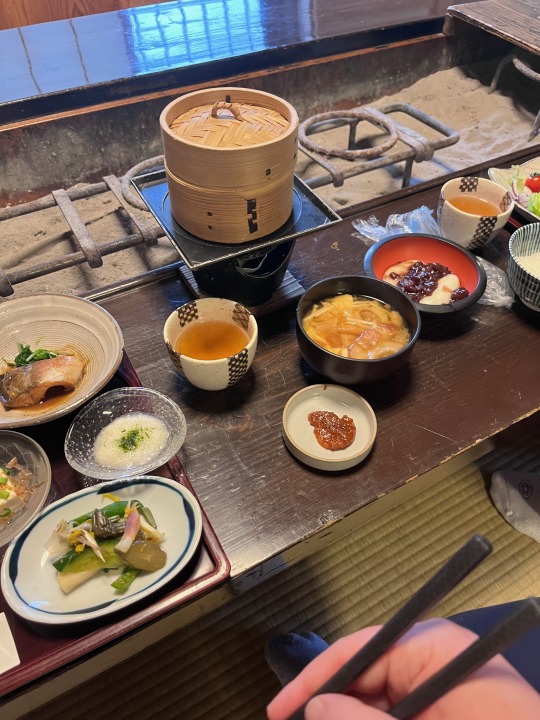
Then we drove around town a little. I forgot to take my phone with me when I got out of the car, like a dummy, so I didn't get great pictures of the tiny shopping district. I got myself a kokeshi, though, and got my father and I a box of karinto manju to split. (YES, I GOT THEM BECAUSE MY FROG GOT THEM FOR ME IN TABIKAERU, SO SUE ME. THEY WERE DELICIOUS.)
We then got extremely lost, but eventually stopped at the public baths. It was seriously pouring and it was cold and miserable so Dad just waited in the car while I took some short baths. Again, I can't show you photos of actual baths I took, but here are a few from online:

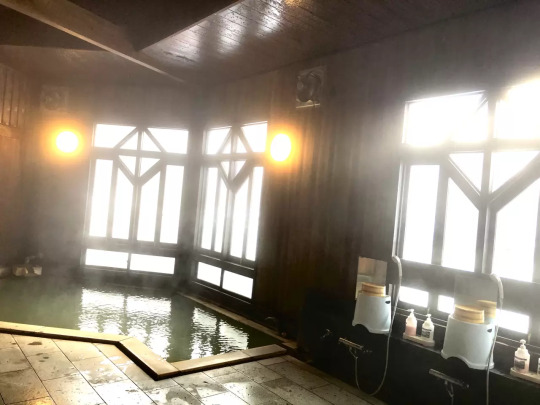
(Caldera Onsenkan)
This one was fun because it was naturally carbonated! They had hot and cold onsen you could bathe in. You couldn't really feel the carbonation in the hot onsen, but you sure could in the cold one. I put my feet in and was like "I am bathing in very, very cold soda" lmao.

(The cold bath for your hands and feet.)
And you could drink it, too! It was supposedly good for you! I only remembered weeks later that shugendō monks were able to self-mummify (more on that later) in Yamagata because their natural spring water was so high in arsenic!
So uh hopefully that one doesn't come back to haunt me. lmao
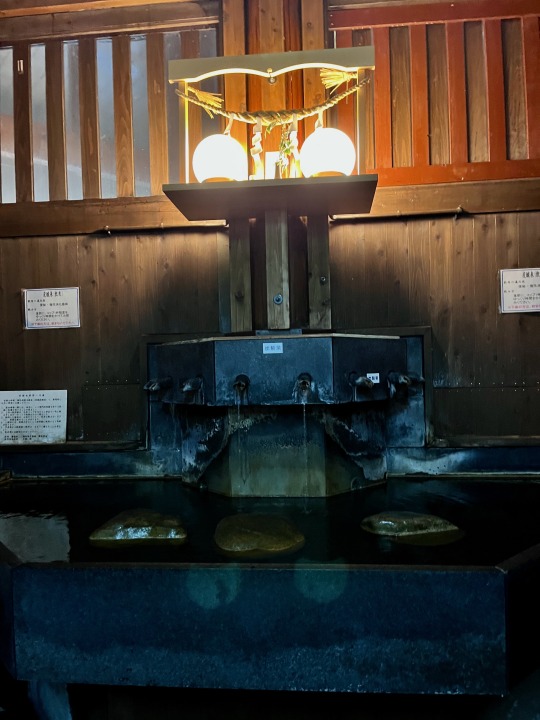

Watch out for the stinkbug.

There was another one in town that I was interested in, too... They say that Hijiori Onsen got its start as a medicinal hot spring town after a monk fell off a cliff and broke his elbow and then rolled into the hot spring and was instantly healed, and this was attributed to Jizo-sama.
So there's an onsen where Jizo will watch over you as you bathe.
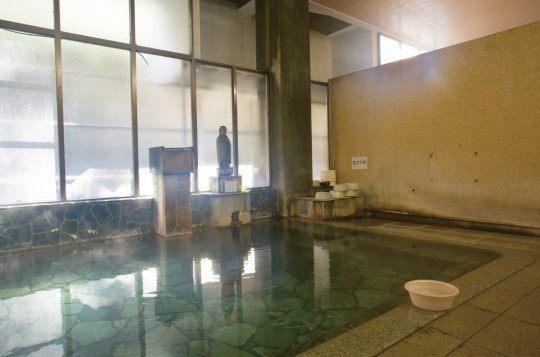
Which is fun, though I liked the similar experience in Kusatsu Onsen a little more. Gotta love a sacred bath, tho.
So then we left to go to the Dewa Sanzan. In the end, we ended up taking our time and stopping a lot at various shrines and stuff because I realized the weather was just too shitty to get a start on the mountains that day. Dad wouldn't even get out of the car except for lunch lmao. By the end of the day, it was hailing, so I can't really blame him.
The next leg of our trip will be in another post because I'm almost out of images in this one, but here's a couple more photos of Hijiori Onsen.

And two more for this round, we did get lost trying to get out of the caldera (...lmao) and broooo when I tell you my dumb ass was like "dad we are for SURE gonna get kamikakushi'd out here"

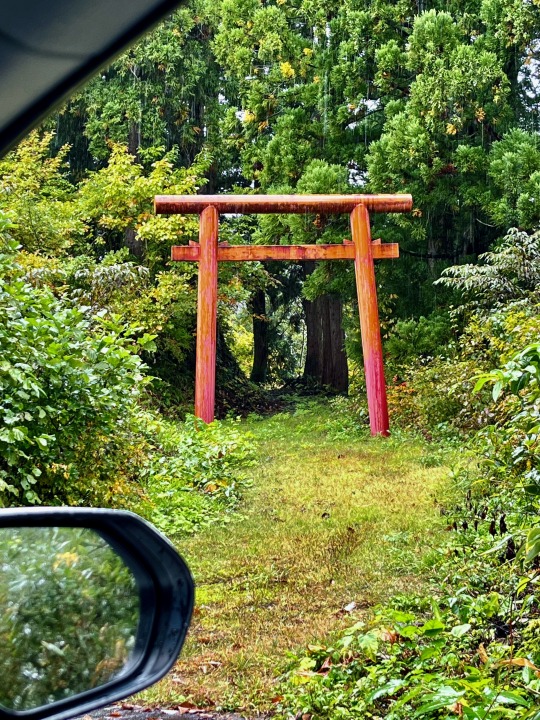
Tell me this doesn't feel like the beginning of a Miyazaki movie lmao.
(we lived, bitch!!! must've been all those sacred baths.)
12 notes
·
View notes
Text
Hoshida Myōkengū

One of my all time favorite shrines in Japan, it's one of the few examples of a shrine that has maintained its Shinbutsu Shūgō heritage, where you can see places to pray to the Buddhas alongside the Kami. It also has a strong link to Onmyōdō.
The main gosaijin are: Ame no Minakanushi no Kami, Myōken Bosatsu, and Chintaku Reifujin-sama.
Getting to the Main Worship Space requires hiking up a huge mountain so you get great views and good exercise, and the shrine itself is built on top of a meteorite site.
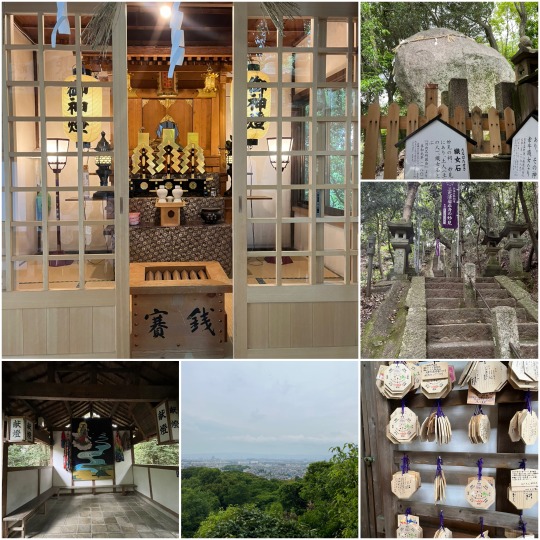
The Official Webpage of Hoshida Myōkengū says:
"According to the legend of this shrine, during the Heian period, during the Kōnin era (810-824) of Emperor Saga, when Kobo Daishi came to Katano, he entered the lion's cave at Shishikutsuji Kisshoin Temple and recited the secret teachings of Buddha's Eye and Mother, and seven stars (the Big Dipper) fell from the heavens and split into three parts before falling to the earth. This legend remains in the area to this day, and it is said that the stars fell in three places: in the Star Forest to the east of Takaokayama along the Hoshida Boji River, in the grounds of Kohoshizan Korinji Temple in Hoshidakan, and in the grounds of this shrine. Later, Kobo Daishi himself visited the site of this shrine, where he called himself "Myoken of the Three Lights, Seiiwa, Shoshin", and it was enshrined as "the sacred mountain of the unique beauty of the North Star Myoken Bodhisattva" and "the famous mountain where the treasure house of gods and Buddhas, the shadows of the heavenly gods and good spirits, come together".
[x]
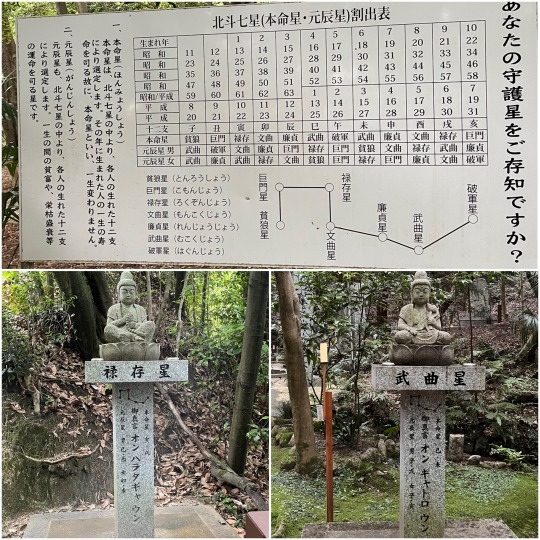
Due to this connection with the Big Dipper and Polaris, the shrine has a tradition of Guardian Stars (守護星), as I was born in Heisei 10, my Zodiac is the Tiger, and my primary guardian star is Rokuzonjō (禄存星) with my secondary star (based on gender) being Mukokujō (武曲星). The shrine has statues dedicated to each star and you can go to each and pray there while reciting their mantras. For example my two stars mantras are
禄存星
オン ハラタギャ ウン
武曲星
オン キャトロ ウン

They also had a lot of beautiful natural areas like this waterfall :)

Of course the shrine items themselves are also stunning. I got a goshuincho for my roommate, and Ofuda and a prayer book for my friend. Of course I went back later and got myself a goshuincho cause of how stunning they were.
5 notes
·
View notes
Text
Shinbutsu shūgō: el sincretismo entre el shintō y el budismo
La historia del budismo japonés es bastante curiosa, no tan solo por el hecho de que este comenzó como una religión independiente y, con el pasar del tiempo, se terminó creando un sincretismo entre el shintō (神道) y el budismo, sino que también por toda la historia que hay entre medio de la introducción de esta religión por los bhikshavah (भिक्षवः [monjes]) y bhikshunyah (भिक्षुण्यः [monjas]).
el shinbutsu shūgō (神仏習合) es un fenómeno muy interesante en japón, por lo que en este blog se hablará sobre este tema y de muchos otros.
La instrucción del budismo a Japón
Fue en el período Asuka (飛鳥時代 [552 - 710 d.e.c]) que el budismo tuvo contacto con el pueblo de Yamato (大和 [Japón]), una religión que fue traída por la bhikshusangha (भिक्षुसङ्घ [comunidad monástica]) que venían desde Zhōngguó (中國 / 中国 [China]) y Goryeo (고려 [Corea]). Y no fue hasta el período Nara (奈良時代 [710 - 784 d.e.c]) que comenzó un fenómeno religioso conocido como shinbutsu shūgō, un fenómeno religioso-cultural que fue creado a base del sincretismo entre el sintoísmo y el budismo.
La historia pre y post del shinbutsu shūgō
Antes de que el fenómeno del shinbutsu shūgō fuese parte de la cultura del pueblo de Nihon (日本), los monjes y monjas budistas dieron una interpretación budista de los kami (神 [かみ]); la sangha monástica no negaban ni aprobaban la existencia de los kami, sin embargo, creían que estos estaban atrapados en el ciclo del samsarah, por lo que los consideraban como seres prthagjanah (पृथग्जनाः [no iluminados]).
A pesar de que la bhikshusangha consideraba a los kami de tal manera, muches acudían a ellos para pedir por protección y la fortuna, por lo que culmino en que la comunidad monástica se convirtió en devota de los kami y, además, en las enseñanzas de Shakamuni Butsu (釈迦牟尼仏 [Shakyamuni Buddha]). Con el pasar del tiempo, los kami fueron considerados bodhisattvah (बोधिसत्त्वाः) y vidyarajah (विद्याराजाः); y fue en el período Heian (平安時代 [siglos IX - XII]) que a los kami se les concibió como buddah (बुद्धाः).
Sin embargo, en el período Kamakura (鎌倉時代 [1192 - 1333]) surgió un movimiento llamada Ise Shintō (伊勢神道) el cual aclaró que los kami no eran ni bodhisattvah ni buddhah, sino que estos eran manifestaciones de los kami.
Lamentablemente, en los años 1868, en el gobierno de Meiji (明治時代 [1868 - 1912]) se creó una orden llamada shinbutsu Hanzerei (神仏判然令), la cual fue creada con el objetivo de modernizar y católico-occidentalizar a Japón; esta orden dio fin al shinbutsu shūgō, creando así el termino shinbutsu bunri (神仏分離), que hace referencia a la separación entre el shintoísmo y el budismo.
Fue entonces que los monjes y los rituales budistas fueron victimas del damnatio memoriae, obligándolos a seguir solo en shintoísmo o a ser exiliados de Japón; además, las tierras budistas japonesas fueron confiscadas por el gobierno Meiji.
Mismo fenómeno, distintos contextos
No solo fue en Japón que se presentó el fenómeno del sincretismo religioso, este tipo de fenómenos lo podemos ver en muchos otros pueblos asiáticos, incluso en otros fuera de Asia, como lo que pasó con Antis, Wallmapu, Kurinka, etc., con el catolicismo y sus religiones tradicionales.
Los nombres de estos fenómenos, asiáticos, sincréticos son los siguientes:
Prathet Thai (Tailandía [ประเทศไทย]): Phrommat (พรหมมต)
Zhōngguó, Heung Gong (Hong Kong [香港]), Táiwān (Taiwán [臺灣]): Sānjiào Héyī (三教合一)
Goryeo: Tongbulgyo (통불교) y Seonbulgyo (선불교)
Việt Nam (Vietnam): (Tam giáo đồng nguyên)
Böd (Tíbet [བོད]): (Chö-nyi [ཆོས་ཉིད་])
Mongol Uls (Mongolia [Монгол улс]): Burkhan Böö (Бурхан Бөө)
Bangladesh (বাংলাদেশ): Bouddho-Dharmo o Lokdhormo (বৌদ্ধধর্ম ও লোকধর্ম)
Asia y la pertenencia religiosa múltiple
Para finalizar este post, les hablaré sobre el fenómeno, que como pudimos ver, es bastante antiguo, de la pertenencia religiosa múltiple, un fenómeno que ha tomado fuerza a lo largo de los años y que hoy podemos ver que el budismo, en el caso de Japón, se consideró como la religión oficial, junto al shintoísmo y el catolicismo, del país, y de muchos más, volviendo con el sincretismo y con mucha más fuerza, además del desarrollo de otras escuelas o tradiciones como el zen, el shotozen, jōdo shinshū, entre otras.
Espero que les haya gustado y servido este nuevo post de budismo; les espero en otra publicación, Āmítuó Fó (阿彌陀佛).
Fuentes:
Kimball D. (31 de Agosto de 2018). Shinbutsu shugo | Buddhism & Shinto's Syncretic Legacy. A Different Side of Japan.
Editores de Encyclopedia Britanicca. (No Date). Shinbutsu shūgō. Britanicca.
Osa Y. (26 - 12 - 2007). Shinbutsu-shūgō 神仏習合. My Shinto.
(21 - 12 - 2020 / 16 - 12 - 2022). Shinbutso-shugo: The Mix of Shintoism and Buddhism in Japan. Japan Wonder Travel Blog.
Teruyoshi Y., Masato S. (No Date). Combinatory Kami. デジタル・ミュージアム.
(No Date). Shinbutsu bunri: separación entre budismo y sintoísmo. Japón Secreto.
#budismo#buddhism#chan buddhism#zen buddhism#tibetan buddhism#chinese buddhism#japanese buddhism#vajrayana#mahayana#theravada
0 notes
Text

9 notes
·
View notes
Note
A long time ago, a book about Shinto I read mentioned something about "warrior priests". I sorta gave up researching them after the shrine they were associated with in the book pulled up no results on English google (forgot it's name, but apparently there's an American branch of it that has way more documentation than the Japanese branch I was trying to look into, but this ain't about that shrine).
The concept of a warrior priest intrigues me, as a fan of media where Shinto priests fight, so could you tell me what you know of them?
I'll be completely honest, I've never heard of Shinto priests that also acted as warriors before this. So I was a bit lost as to what to do here.
However, I do know of the much, much more famous Buddhist warrior monks, called sōhei (僧兵 lit. "monk soldiers"), which I originally planned to use as my answer.
Fortunately, it is in the middle of researching them that I believe I came across a good answer to your question, but first, let's go over some history (which I've tried my best to keep brief and relevant to our topic today).
History of Shinto and Buddhism
Shinto and Buddhism have been closely intertwined for most of Japan's history. In fact, for a good part of it, most people would've understood them as a single system of faith, one and the same.
From our modern point of view, we call this shinbutsu-shūgō (神仏習合), the "syncretism of kami and buddhas" (syncretism being the combation different beliefs; Kami being what I usually refer to as the Shinto "gods").
It was not until the Meiji Restoration in 1868, when the "Kami and Buddhas Separation Order" (神仏判然令) was decreed, that the two religions for forcefully split in twain.
Yet even still, the two were never truly and completely separated, many Buddhist temples still house small Shinto shrines, and some Shinto shrines are dedicated to Buddhist deities like any other kami.
Indeed the policy never succeeded in its goals to separate the two religions, many Japanese people still practice both and visit both shrines and temples, but what it did do was create the modern view that they are separate, independent religions.
Practices/Beliefs Under the Syncretism
Right, now we can take a look at the practices under the syncretism that lead to these "warrior priests/monks" that I mentioned prior.
To keep things brief, basically, the Shinto gods and the various Buddhist deities (Buddhas, bodhisattvas, etc.) were fused together. The "how" was never agreed upon, but the mainstream idea was the honji-suijaku theory (本地垂迹).
It suggested that Shinto gods were but local manifestations of the buddhas and bodhisattvas, and that they too were not exempt from the cycle of death and rebirth, samsara.
Thus, Shinto gods needed to achieve enlightenment, nirvana, as well, just like us humans. Buddhist temples were built close to Shinto shrines so that the gods can listen to Buddhist sutras, cultivate good karma, all that good stuff.
There's a lot more too, like how Shinto gods later come to be considered the protectors of Buddhism, but the important takeaway here is that Buddhist temples and Shinto shrines slowly get fused with one another, to the point where they're basically the same thing.
Warrior Monks and Priests
It is under these syncretistic beliefs and practices that we move onto classical and feudal Japan, specifically the period from the late Heian period (794 to 1185) until the Muromachi period (1336 to 1573).
During this period, power in Japan was split between three: The imperial court, independent warrior governments, and what is called the "temple-shrine powers" (寺社勢力) (the "why" is a lot of history I really can't).
(Also do note that these are categories, not three unified powers, so all the temple-shrines didn't come together to form their own government or anything like that.)
Temple-shrines then held vast amounts of land and power, enough to compete with the other two powers for authority. A part of this competition and exertion of power is, of course, military fighting.
This fighting, on the part of the Shinto shrines, were often done by what are called jinin/jinnin (神人), low-ranking priests who did chores and odd-jobs for the shrine. Some of them where charged with guard duty, so they owned weapons and knew how to fight.
It was these people who we see join the sōhei (mentioned in the beginning) in their fighting, and we even have many records of people complaining about their violent rampages (yeah not all of these warriors were great people, in fact many weren't, but that's neither here nor there).
And there's what I believe you read about! Warrior Shinto priests, albeit low-ranking ones that were basically the odd-jobs guys. (Also worth noting is that not all jinin were warriors, some were farmers, merchants, artisans, etc.)
Ending
What I couldn't find
I should definitely add that I couldn't find anything about a specific group of jinin tied to a specific shrine.
The only two American shrines that I could find with specific ties to Japanese shrines are the Tsubaki Grand Shrine of America and the Izumo Grand Shrine of Hawaii, tied to the Tsubaki Grand Shrine and Izumo Grand Shrine respectively.
However, I couldn't find anything specifically tying them to any temple-shrine powers back them, nor any specific anecdotes about their priests being warriors either.
So yeah I got nothing on that front, sorry 'bout that.
Why all the history?
In retrospect all that history really seems rather unnecessary, doesn't it? But I've already typed all that up, and it'd just be an absolute waste to delete them now.
I originally mentioned all that because I wanted to give an idea on how this could've been obscured, both to me and to anyone else, and hence the topic's obscurity these days.
Shinto was Buddhism at the time (and vice versa, in a sense), so these people who fought with Buddhist monks were simply lumped in with them, they were of one temple-shrine organisation.
There's a lot of stuff in there that you can easily pour literal lifetimes into learning about, so we can always visit some other stuff there if you're interested~.
Final Words
Good gods I crammed a lot in here.
The tricky thing is that any talk about Shinto history also kinda necessitates a basic understanding of Buddhism, so it's tough to pick out what's really needed and what can be saved for some other day.
Also I'm not nearly as good at these top-down perspective stuff, as you may have noticed, narrow topics are a lot easier to work with (though I suppose that's true for most things).
And this intersected with history quite a lot too, which is not really my thing and I'm not nearly as well versed in.
Finally please do note that I'm no expert in Japanese religion and mythology or anything. I just find it all real neat~. So please don't be surprised if any of this turns out inaccurate or straight up wrong, and do tell me I'd love to learn too~.
And that's all I believe! As usual, I hope you enjoyed~! :)
#oh also sorry for no pictures!!#I like to have them to break things up but abstract stuff like this is kinda hard to find pics for#no idea what else to tag this honestly#no matter tho I'll add it to the Len'en masterpost for now#inappropriate as it may be#rather that than have it lost to the flow of posts#I'll make one for these once I have a few more maybe
8 notes
·
View notes
Text
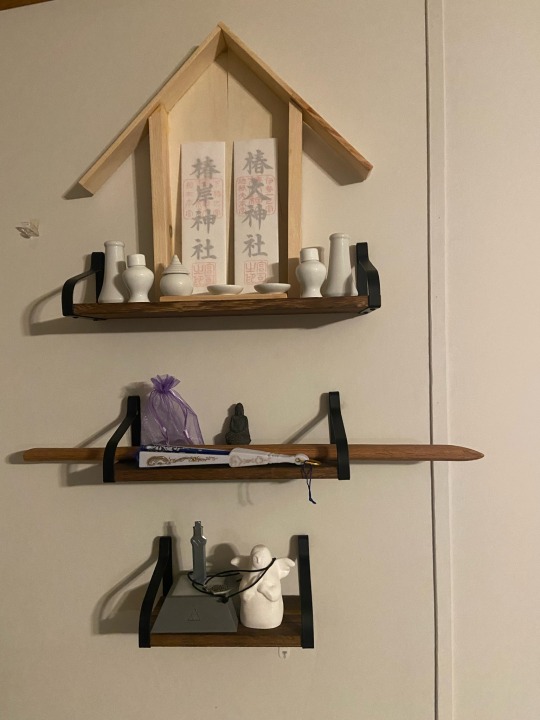
In this modern world connected by the internet, it is beyond easy to be spiritually eclectic. Christianity of various forms, pagan reconstruction, traditional cultural religions, you name it! However, this tends to lend itself to a few problems.
One such issue is the common sense of entitlement to practice whatever tradition we want however we want, even if it is a closed or initiatory practice. There are so many various open practices that there is no reason to enter into what is a closed or initiatory practice, unless you are allowed to join by the community it belongs to and initiated into it.
Another issue is the tendency to blend practices. For example, I’ve seen people worship Inari Ōkami, Shinto deity of harvest and prosperity and Loki, the Norse deity of chaos and trickery on the same altar. That isn’t to say that you can’t be both Shinto *and* Heathen. You absolutely can, but it is considered incredibly rude to mash these faiths into one when they are both due our full respect. How this would look would be to practice both but keep them as their own separate things. Following the laid out example, one could absolutely have both a Shinto kamidana and a Heathen altar.
There are, however, some forms of traditional syncretism. An example of this is Shinbutsu Shūgō, a syncretism of Shinto and Buddhism. This is one of my spiritual practices. A Shinbutsu approach to Tsubaki faith, praying to Sarutahiko no Ōkami and the other enshrined kami at Tsubaki Grand Shrine but also maintaining Buddhist meditation practices and views since my priest told me that was acceptable for our faith.
However, I also find myself interested in something known as Pop Culture Paganism where one may choose to revere a pantheon of gods from works of fiction, or maybe even create a pantheon of gods from the characters of a work of fiction. This is essentially what I mean when I said I am a Knight of Hylia and a Sage of the Triforce. The Legend of Zelda has influenced me to such a large degree in my life that I find myself feeling deep respect for what world building we have received and so I am forming my own path where I revere the Three Golden Goddesses and the other important figures in lore. Din, Nayru, and Farore created the world in which Hyrule exists. Goddess Hylia was entrusted with protecting the Triforce and life in the world from the demon tribe. Goddess Hylia becomes Zelda and her Chosen Hero becomes Link. I view Link as an embodiment of the Triforce of Courage and Zelda as the Triforce of Wisdom. These characters are like archetypes to follow. Ganon becomes a cautionary tale of what happens when people lust after power too greedily. Beyond these goddesses and demons, we also meet many beings in the world of Hyrule who are essentially kami of the world. The Great Deku tree, Lord Jabu-Jabu, The Light Spirits, and many more.
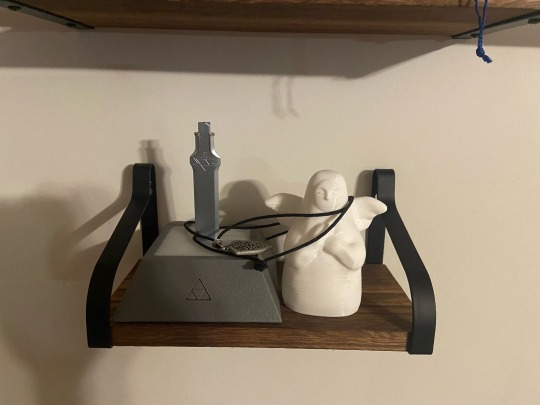
Here is where I reach my point—
I do my best to show each of my practices their due respect and veneration by keeping them their own separate things but this is one area where it is a bit difficult. Keeping this Hylian Faith separate from Shinto and Buddhism isn’t easy because the lore of Legend of Zelda is *heavily* inspired by Shinto and Buddhism. In that regard, this Hylian Faith almost *is* the real world faiths, but with western fantasy flavors.
So while it won’t always be easy to keep them separate, I will do so since Shinto and Buddhism are traditions thousands of years old, this Hylian Faith is something new inspired by the old. And that’s totally ok!
#hylia#legend of zelda#meditation#spirituality#triforce#shinto#buddhism#shinbutsu#Shinbutsu Shugyo#kami#Sarutahiko no Ōkami#heathen#norse paganism#eclecticism
18 notes
·
View notes
Photo
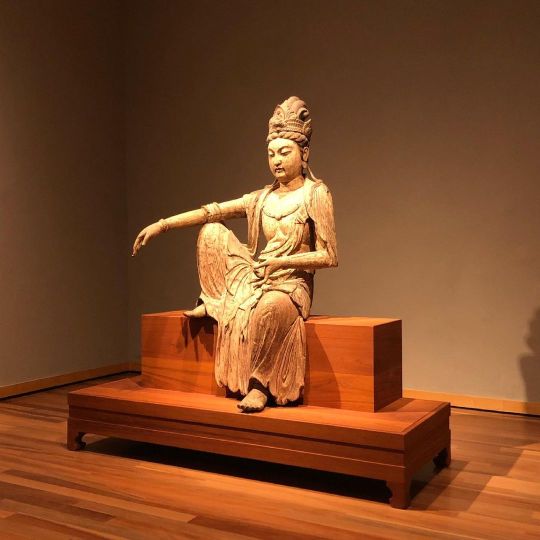
I went to the Honolulu Museum of Art today and visited their galleries for the first time in years. One of the fondest memories I have with my late grandmother was going on trips to the Academy. Out of all the pieces in particular, grandma used to say I loved this Guanyin or Kannon statue the most. According to her I would sit on the bench in front of the statue and talk to him (this is a now less common masculine depiction of the deity) every time we visited. Seeing him again made for a very nice reunion. Aside from this Bodhisattva I also re-discovered a statue of Aizen Myō’ō the Wisdom King who transforms sexual desire into spiritual enlightenment and has been adopted by the Japanese LGBTQ+ community as a guardian god. I also found three Shintō Kami-sama; two unnamed deities and Sōgyō Hachiman-sama. These hinoki statues were carved between the 9th and 13th centuries when Buddhist influence spread with shinbutsu-shūgō and shrines began using art to depict their gods. The two statues wearing the tate-eboshi (立烏帽子) hats are the unnamed Kami-sama and the bald statue is Hachiman-sama. It was so great to be able to see all of them. #honolulumuseumofart #homa #museum #art #japanese #statues #shinbutsushūgō #shintō #kami #kamisama #buddhism #gods #kannon #guanyin #aizenmyōō #deities #sundayfunday #hachiman (at Honolulu Museum of Art) https://www.instagram.com/p/CQpGhUsH5PW/?utm_medium=tumblr
#honolulumuseumofart#homa#museum#art#japanese#statues#shinbutsushūgō#shintō#kami#kamisama#buddhism#gods#kannon#guanyin#aizenmyōō#deities#sundayfunday#hachiman
2 notes
·
View notes
Text
RIFT
RIFT is an obscure Discipline -- rare in the extreme, born of anguish & remorse, sharpened through tear-streaked centuries of nightly struggle against the most obscene appetites -- that allows practitioners of its weird, flagellant art-form to coalesce their Beast into a quasi-living, sentient Umbral Realm bound eternally to their shadow: a sprawling, labyrinthine nightmare-dimension.
Through this monstrous realm, the Damned may walk.
And in this place, other things -- ancient things, titanic, hungry and inhuman -- soar corpse-pale skies lit by rotting, pulsating black stars, and dive through creaking forests of twisted-iron atrocity rising from endless oceans of blood.
Rift is an updated Discipline designed for use with Vampire: the Masquerade 20th Anniversary Edition, inspired by content from A World of Darkness (First Edition, 1992).
Brought to you absolutely free to enjoy, to test & to share – as always – by the fine folks of my Patreon.
If you enjoy this content and would like to see more dark, modern horror game-material by the author, the Bloodlines & Black Magic Kickstarter is going on right now.
Hugest of thanks to John Miętus for his invaluable editing-assistance and development during the creation of this fan-content.

image from here
HISTORY
In the long black centuries between the rise of the Baali from their cursed organ-pit and the ascendance of House Tremere to majestic undeath, it is known that Saulot performed innumerable private pilgrimages to far-flung, moonlit realms in an eternal, fruitless search for the enlightened state whispered of as Golconda.
Some occult scholars claim that, in desperation, the Antediluvian sat silently for several decades at the feet of Shinbutsu-shūgō masters, wreathed in holy incense, the toll of tsurigane and a coil of unending thirst: contemplating the infinite sins of his undying lineage, reflecting upon his Heaven-ordained duty to his Progenitor and seeking to divest himself of all worldly attachment.
If so, it is possible that his incalculable and fathomless meditations produced the first echo of what would come to be known in later millennia as Rift.
Whether this is truth or mere fabrication, students of esoteric history trace the first known demonstrations of the Rift Discipline to a nomadic brood of Malkavians calling themselves ‘Gaki’ -- or ‘Hungry Ghosts’ -- who hunted the Silk Road during the 8th century. These wandering, blood-drenched emperors of jade & dust claim to have been taught the technique by a wandering Far-Eastern mystic who bore a shining third eye upon his brow & spoke in koan-like riddles about the Ten-Thousand Hells awaiting the Children of Caine.
The Gaki Bloodline
Rumors persist that a true bloodline of Malkavians -- or Malkavian Antitribu -- eventually emerged from among the far-wandering Gaki coteries, and that the eerie bloodline persists into the modern nights; a minority of Gehenna researchers claim that a cabal of such creatures were active in Tokyo as recently as the 1970s, drifting silently through the long, smog-shrouded neon shadows of that vast metropolis in search of fresh-spilt blood.
If there is any truth to these claims, those of the Gaki Bloodline suffer the full Derangement weakness of their parent clan; in addition, their perceptions are twisted by their hunger: when a Gaki is down to a number of Blood Points lower than her Humanity or Path rating, her world fades into a sinister & ghostly sea of potential victims, immediate physical threats, drifting fog and the whispers of the kumonosu. During this time, she is unable to focus on any other input -- such as traffic lights, the distant sound of gunfire or whether she’s standing in an apartment, on the street or in a fetish-club -- unless she expends a point of Willpower to shake off the unreal cloak of her hallucinations for the remainder of the scene.
The Gaki possess the Bloodline Disciplines of Auspex, Obfuscate and Rift.
Elder members of the Bloodline are known to have traded extensively in ancient nights with far-voyaging Gangrel of the Silk Road, and often possess some combination of Animalism (for use in controlling the Beast), Fortitude (for use in surviving botched Courage rolls when evoking Rift) and Protean (for general use in traveling the winding paths of the world in safety).
Since that time, the Discipline has vanished and resurfaced repeatedly, passed from master to apprentice; in these Final Nights, it is as likely to be practiced by a Nosferatu neonate dwelling in the gutters beneath a methadone clinic as it is to be wielded by a salon of elder Toreador Antitrubu who make an art of their own grandiose self-destruction.
The technique is very quietly forbidden within the Camarilla, as a pair of recurring themes amongst those who practice the art-form are a fondness for Diablerie and a penchant for experimentation in Dark Thaumaturgy ... although knowledge of the art is also -- somewhat surprisingly -- kept in secret among several coteries of particularly puritanical Josian devil-hunters.
REQUIREMENTS
Rift may only be taught by another, more-experienced master of the art-form. It cannot be learned from demons, spirits or other non-Kindred tutors. It cannot be gained at Character Creation nor selected as a Caitiff Discipline or Additional Discipline (pg. 494) unless explicitly approved by the Storyteller.
Once a Kindred has a greater number of dots in Rift than she possesses in any other Discipline, she may thereafter instruct herself in the Discipline through meditation; after this time, she no longer requires a tutor.
A Kindred may only possess a total score in Rift equal to one half the total number of points of Humanity she has lost since her Embrace.
Thus, a Kindred may not gain her first dot of Rift until she has lost at least 2 points of Humanity. If she wishes to gain a second dot in Rift, she must have lost at least 4 points in Humanity.
An elder who wishes to gain her sixth dot in Rift must, therefore, have lost at least 12 points in Humanity over her long, blood-splattered unlife.
In addition, upon gaining her first dot in Rift, the practitioner of this art gains the Nightmares Flaw (pg 485). She gains no bonus points of any kind for accepting this Flaw. If she already possesses Nightmares, the novice practitioner of Rift must instead select another Mental Flaw -- such as Deep Sleeper or Lunacy -- as deemed appropriate by the Storyteller, representative of her new reality: each time she slumbers, she is pulled deep into her own Rift to experience the most grotesque of tortures at the hands of her Beast ... and all its victims.
Note that proficiency in Rift is in no way dependent upon a vampire’s current Humanity total: a vampire with a Humanity of 10 could freely learn & utilize five full dots worth of Rift, so long as she had lost at least 10 points of Humanity at some point in her past.
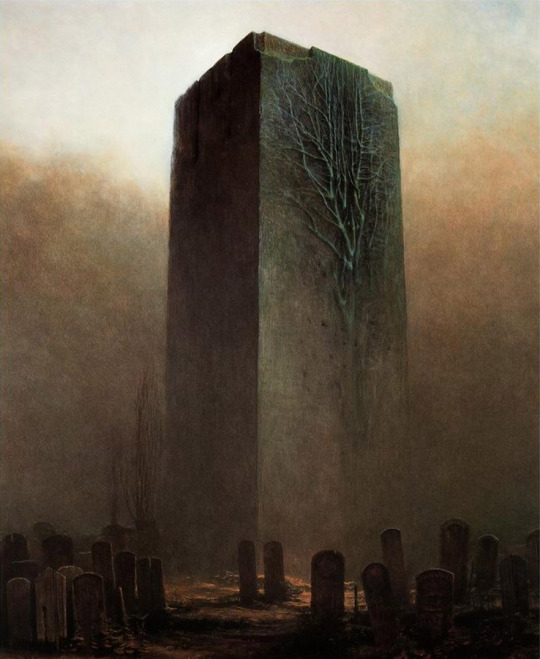
image from here
PHILOSOPHY
Rift is, fundamentally, about grief & regret.
It is about falling into the Abyss. It is about witnessing yourself lose the grand, shadow-draped chess-match against your own ravening Beast in a slow, ugly war of attrition. It is about shame, sorrow & self-reproach. It is about confronting your own subconscious desire to be punished for your sins, watering this garden with blood, and allowing the tangled forest of self-hatred to grow wild, dark & unchecked. It is about accepting one’s own damnation and the personal hell that comes with it, facing-down your worst fear wrought in a storm of ash & flame, and dying -- torn into a thousand screaming fragments -- over and over and over again.
It is about what awaits you in the dark, whether at the end of another blood-slick night of terror or at the final, jagged end of a squandered immortality.
On the surface, of course, Rift is about bridging the world of flesh to the nightmare realm, dancing along the weirding way between them with a twist of will & blood, flaunting the crude, limited physics of this concrete universe.
And, up to a point, it is that as well.
For these reasons, tutoring a potential student in Rift is prohibitively difficult.
For one, it is near-impossible for an instructor to gauge how much torment their would-be apprentice has already endured. Has this supplicant to the power you wield already begun to feel her soul & sanity crumble, crawling her way back up with broken fingers from the awful precipice of the gaping, blood-slick pit?
Or is she a mere pretender to such evil?
If she has not yet begun to grow her own Rift & populate the personal hell that she will soon steal-into like a thief, how do you tell an apprentice “go now, and commit atrocities, that you might regret them later?”
How do you remind her that the Beast is ever hungry, that it feasts with cold delight in the deep blackness upon those who would seek to dance around it?
Most Kindred simply do not possess the temperament to master Rift, and it is all but unknown among those who walk a Path of Enlightenment.
SYSTEM
Much like Obfuscate, Rift requires no expenditure of Vitae to activate its power. It requires concentration and cannot be used in Frenzy.
In addition, it is -- in theory -- quite a subtle power, with few obvious effects visible to the outside observer.
Any use of Rift automatically causes all mundane and electronic recording equipment within line of sight of the practitioner to glitch-out for a split-second; a video-camera cannot capture an image of hell by training on the Damned, instead recording only a few frames of static & distortion.
However, a practitioner of the Discipline must always first attempt a Courage roll whenever she channels the nightmare of her own private damnation; attempting this roll does not require an action, and the Difficulty of this roll is always equal to 4 + the level of the Discipline power to be activated.
DECLARING INTENT
Whenever a Damned chooses to activate any ability of the Rift discipline, she must specify exactly what level of the Discipline she intends to use. She cannot, for example, activate Step Upon the Nightmare Bridge and then -- once within her Rift -- decide to activate Dance of Unstable Nightmares unless she immediately attempts an additional Courage roll.
If this roll is unsuccessful, one of the following three things occurs:
the ability fails, as the Damned -- at the last moment -- draws back in terror from the eternity of suffering she has built for herself, brick by blazing & razor-wreathed brick.
the Damned may expend a point of Willpower, forcing open the gateway between worlds through sheer desperation.
the roll is a Botch, which has special rules noted below.
If the practitioner chooses to force the power of her Rift upon the unsuspecting world in this way, the effects of her Discipline are Obscene, as noted below.
A practitioner of Rift may always choose to voluntarily fail her Courage roll (no roll required), expend her Willpower and unleash her Rift in a wave of Obscenity, if she so desires.
If the Courage roll is Botched, the practitioner is consumed in a wave of horror & nightmare-flame emanating from the Rift bound to her. This deals a number of levels of Aggravated damage equal to the level of the Discipline power to be activated.
This damage may be soaked as normal (via Fortitude).
This damage is additionally reduced by one level for each religious item or icon the Damned carries; these items are destroyed utterly when the raw power of her unleashed Rift tears through her: silver crosses are deformed into unrecognizable twists of tarnish & rust, wooden prayer-beads blaze for a single moment with unholy fire before being reduced to greasy ash, and earrings emblazoned with the Sacred Heart shatter into splinters of smoking ruin with a bitter scream and a waft of brimstone.
The Damned may carry a total number of such items or icons equal to her Humanity score. These items must be worn or carried for at least 24 hours before they may be sacrificed in this way.
Note that religious items carried by the practitioner of Rift must match the faith (if any) of the Damned: atheist Kindred cannot benefit from them at all, and most creatures cannot gain the benefits of both a Star of David and a Holy Rosary at the same time.
Members of the Gaki Bloodline, famously, were the exception to that rule: true Universal Polytheists, they adorned themselves with sacred items from every culture they encountered, practicing as many good-luck & purification rituals as they could learn in an eternal mania to ward-off evil.
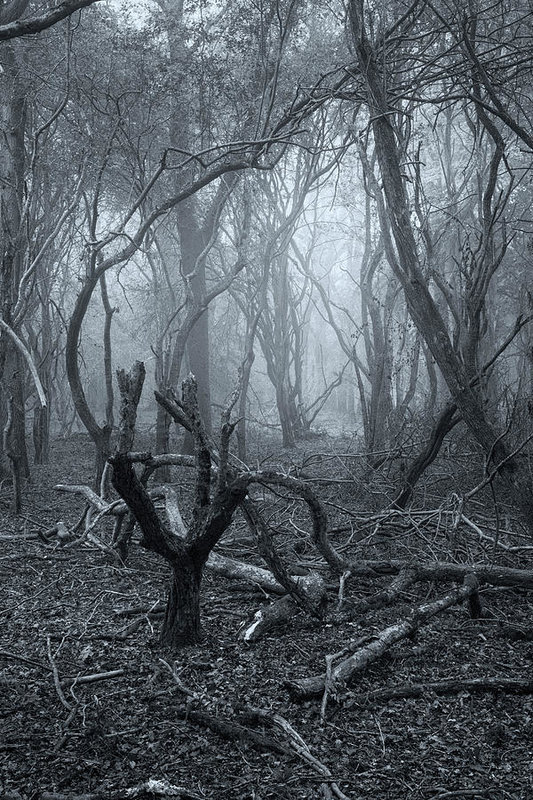
image from here
LEVEL ONE:
Echo of Hells: Upon activating this technique, the practitioner of Rift chooses any one creature who likewise suffers the hunger of an undying Beast; she may communicate silently with that individual for the remainder of the scene.
This creature must be within line-of-sight to the Damned for contact to be established (but see below).
All attempts to communicate with this creature are automatically successful unless the other Damned chooses to block such contact; a Howl of the Devil-Tiger Kuei-jin who speaks only Early Middle Japanese may choose to ignore the alien whispers of a Western undead channeling the screams of her Rift, but their communication otherwise surpasses all language barriers.
If the Damned chooses to communicate with a fellow practitioner of the Rift Discipline who is known intimately to her, this communication may be performed over any distance; she must know the name, face, scent, touch and taste of her partner before communication may be joined in this way.
This technique, at the Storyteller’s discretion, may be used to communicate with creatures including ghouls, as they are subject to Frenzy, as well as Black Spiral Dancers, Nephandi, Formori and Risen but it cannot -- for the most part -- otherwise be used to communicate with mortals.
Obscene: If this technique is unleashed as Obscene, all creatures within ten feet of the chosen target hear a cacophony of discordant & hideous whispers emanating from the target for as long as your communication lasts.
Unlike more potent gifts of this Discipline, mere exposure to this technique is not enough to harm flesh.
LEVEL TWO:
Unveil Damnation: By use of this technique, the practitioner of Rift may draw another into her shadow-realm of eternal agony, if only for a moment, forcing her target to bear witness to the vampire’s private hell ... and to endure, for the space of a mortal heartbeat, its myriad torments.
This is a fully-immersive psychic onslaught: the victim cannot avoid this experience by averting her eyes, nor by covering her ears and screaming, although many creatures will instinctively attempt to do so.
ON THE TEN-THOUSAND HELLS
It is known that each Rift opens upon a different realm of perfect suffering, each uniquely tailored by the Beast of the Damned to accentuate the fear, shame, violence, frustration, guilt, trauma and horror they have endured ... and perpetuated, returned onto them a thousand-fold.
Before a player may gain any levels in the Rift Discipline, she must be able to describe to her Storyteller the basic nature of her particular damnation: one might be a breathtakingly beautiful rain-drenched forest, with a different victim of the Damned crucified upon each tree, through which she is chased in nightmare by the flaming corpses of all those she has Diablerized; another Rift might open into an endless, boiling desert of black sand, pillars of salt, coils of rusted razor-wire and pits of jagged glass shards, watched-over eternally by seven hateful, cataract bio-luminescent spheres roiling across the bruise-colored sky in a chorus of screams.
A Storyteller should work closely with her player to help detail this realm, drawing from the character’s misdeeds, phobias and failures.
This ability functions identically to the Level 2 Presence ability Dread Gaze (see page 194) with the following adjustments:
The Damned rolls Perception + Awareness to determine her success with this ability rather than Charisma + Intimidation.
This is not a Presence ability and is thus not subject to defenses such as Pavis of Foul Presence (pg. 236).
The victim of this technique may immediately attempt a Perception + Empathy roll (Difficulty equal to the practitioner’s current Willpower). If this roll is successful, she gains deep insight into the Nature, Demeanor, psychology and morality of the Rift-practitioner; at Storyteller discretion, this may give the victim an advantage against the Damned in later scenes or allow her to predict the Rift-practitioner’s next move.
Obscene: If this technique is unleashed as Obscene, all creatures within ten feet of the intended target bear witness to the same flash of utter horror ... and are thus subject to the effect of the ability (although the Difficulty to terrify these additional targets is doubled from its base; the Damned rolls Perception + Awareness separately for each target). Each target, as normal, may attempt a Perception + Empathy roll to analyze the tormented inner psyche of the Rift-practitioner.
In addition, the initial target of this ability suffers one level of lethal damage from exposure to such horror; the Difficulty to soak this damage is equal to 2 + the level of the Discipline used (see below).
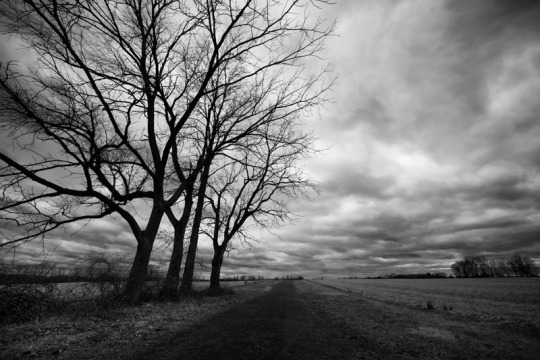
image from here
LEVEL THREE:
Step Upon the Nightmare Bridge: By use of this technique, the Damned may depart the world and physically enter her own Rift, vanishing as she steps backwards into her own shadow.
The Damned is invisible & intangible while hidden within her Rift, but she may be observed as an eerie, discolored silhouette in empty space by any outside observer scanning the area with Auspex or a similar supernatural perception ability.
She may only carry clothing, keepsakes, one-handed weapons and other small personal items with her when she steps into her Rift in this way; she may not carry other creatures with her, nor anything that requires more than one hand to hold. Any object too large, heavy or bulky to be carried across (subject to Storyteller discretion) is simply dropped at her feet in the world of the living when the Damned steps into her own Rift in this way.
Experienced practitioners of Rift can often instinctively guess what objects are too large to be carried across in this way, and are rarely surprised at being stripped of their held possessions when evoking this technique.
The Damned may choose to leave items within the realm of her private hell and retrieve them later.
At the conclusion of each turn spent in her personal hell, the Damned must succeed at a Courage roll with a Difficulty equal to her Conscience. Upon failing this roll, she returns to the night-lit world of the living. She may always choose to return of her own volition before failing this roll. Returning from her private hell does not require an action.
The Damned is always aware of what occurs directly on the other side of the veil between worlds -- in the space she previously occupied -- and may gaze out of her personal hell to observe the world beyond without any roll.
The Damned always returns to the living world in the same spot from which she departed, stepping back into the space she previously occupied.
Obscene: If this technique is unleashed as Obscene, the depths of the practitioner’s personal hell are briefly visible for all to see as the Damned steps backwards; all creatures who witness the Damned vanish are subject to the Obscene version of the Level 2 Rift ability Unveil Damnation, as above. In addition, the Damned leaves residue from her private hell on all surfaces with which she was in-contact when this technique is activated, potentially marking the floor upon which she stood with foul rain-water, drifts of ashen rust or tiny shards of gore-caked bone, glass and ceramic tile.
The practitioner of Rift may choose a single target within her line of sight when she uses this Unveil Damnation ability to be the initial or “intended” target of the ability. She must stare directly at that single target when this technique is activated.
LEVEL FOUR:
Dance of Unstable Nightmares: When the Damned exits her Rift, she may choose to reappear in any place in the living world that she can see clearly.
Thus, she might return to the world standing atop a building visible from her previous location, but not on the other side of a locked door.
Obscene: As Step Upon the Nightmare Bridge, above, except that the Damned additionally brings residue from her private hell with her when she exits that hideous realm, marking her passage in two places.
LEVEL FIVE:
Call-Forth the Majestic Nightmare: When the Damned enters her Rift, an entity from deep within her Rift is pulled into the night-lit world of the living; this creature immediately occupies the space vacated by the Rift-practitioner.
This entity is the true Beast of the Damned made manifest in flesh. Its specific appearance is left to the player and her Storyteller to decide, although it is always visually identifiable as -- at least in some way -- similar to the Damned who summoned it up from her personal Wheel of Punishment. It also bears an uncanny resemblance to any creature diablerized by the Rift-practitioner.
The entity possesses statistics identical to the Damned, with the following differences:
The entity is always in Frenzy and has a Humanity of 0. If the entity ever leaves Frenzy, it immediately vanishes.
The entity gains all the benefits of Black Metamorphosis (pg 189), Horrid Form (pg. 242), The Form of the Cobra (pg. 210) or a similar physical enhancement effect (such as the Fractura ability of Striga), as chosen by the Storyteller.
The entity is not bound in any way to creatures who hold a Blood Bond over the Damned, nor is it subject to similar emotional restraint or control (as adjudicated by the Storyteller).
The entity will preferentially target anything it sees as a threat to the Damned that created it, and will always attempt to murder anything that attacks it.
Once its safety is secured, the entity turns its abhorrent attentions to the living world. The entity hates the practitioner of Rift who called it forth and seeks to cripple & disfigure all that the Damned holds dear, targeting allies & friends of the Damned if it is able (although it does not attempt to destroy them outright).
In any instance, the entity revels in utter destruction.
When the practitioner of Rift returns to the world, the entity vanishes.
Any blood consumed by the entity is wasted when it vanishes.
Obscene: As Step Upon the Nightmare Bridge, above, except that the nightmare entity constantly drips (or sheds) matter from the depths of the practitioner’s private hell, leaving a trail of horror as it rampages.
------
Cross the Nightmare Bridge: When the Damned chooses to enter her own Rift, as per the Level 3 technique of this Discipline, she may remain within that nightmare realm for an indefinite period of time (no Courage roll required). She must slumber, as normal, when sunlight falls on the living world beyond, and her thirst grows nightly: there is no blood to drink within the confines of her hell.
If the Damned falls into torpor while beyond the borders of her Rift, she falls backwards out of her own shadow and returns physically to the living world.
She is otherwise free to explore the boundless realm of her eternal damnation as she pleases.
Obscene: As Step Upon the Nightmare Bridge, above.
------
DEVELOPER’S NOTE:
Unlike the majority of Disciplines, Rift allows access to two distinct Level 5 powers. Access to these two different abilities is treated identically to Elder Disciplines such as Karmic Sight and Mirror Reflexes (pg. 140-141).
------
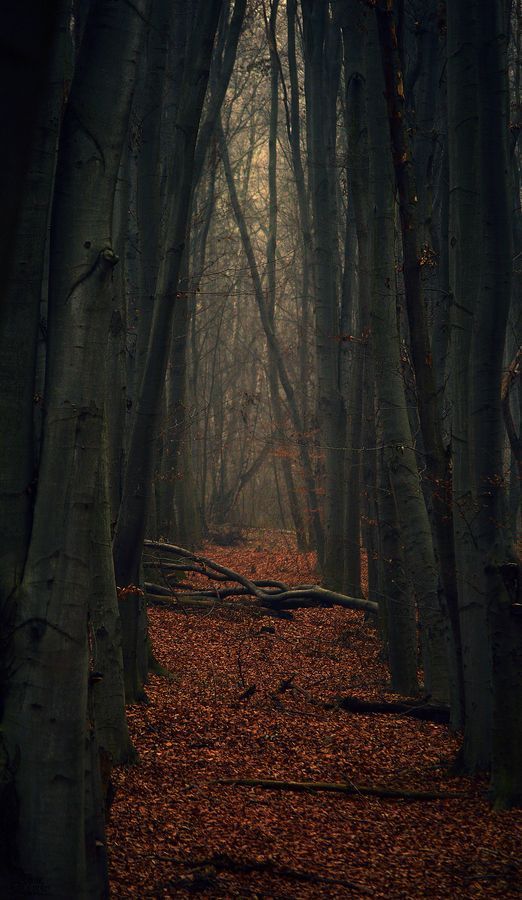
image from here
LEVEL SIX:
Distend & Evacuate the Nightmare Hoard: By use of this technique, the Damned may deposit any inanimate object held in-hand into her Rift; the object seemingly vanishes, like a card disappearing in a display of slight-of-hand. Only an object that might be transported via Step Upon the Nightmare Bridge may be relocated into the depths of a private hell in this way.
The Damned may likewise draw-forth any object deposited into her private hell.
Obscene: If this technique is unleashed as Obscene, the item enters or exits the Rift in a wave of unhealthy matter from the depths of nightmare, dripping bits of a private hell into the waking world. An item drawn from the Rift in an Obscene way radiates palpable, toxic waves of this energy, and deals 1 level of Lethal damage to any creature (except the Damned) touching it within the next minute. The Difficulty to soak this damage is equal to 2 + the level of the Discipline used (see below).
-----
Sinister Winds of Unstable Nightmare: By use of this technique, the Damned may choose to deposit any waking-world object held within her private hell in a location she can see. Targeting a particularly specific location with the object -- such as ‘the small space between my opponent’s glasses and his eyes’ -- when the object emerges requires a Perception + Occult roll, Difficulty 7.
Obscene: As Distend & Evacuate the Nightmare Hoard, above.
LEVEL SEVEN:
Covetous Eyes of the Nightmare Thief: By use of this technique, the Damned may deposit any unattended inanimate object within her line of sight into her Rift. Only an object that might be transported via Step Upon the Nightmare Bridge may be relocated into the depths of a private hell in this way.
Obscene: As Distend & Evacuate the Nightmare Hoard, above.
Doorway Out of Hell: By use of this technique, the Damned may establish a permanent physical exit from her Rift into the living world, usable only by her. This portal requires only a moment to establish: the Damned must touch an open, bounded doorway or archway of any kind -- such as a torii gate or a closet door in the home of her ghoul -- and expend a permanent Willpower. The Damned may always choose to exit her Rift through this doorway, rather than returning to the world at the spot she entered her private hell, or at a point in space within line of sight (as per Dance of Unstable Nightmares).
This doorway may not be used to enter the Rift.
The Damned may posses a total number of doorways out of her Rift equal to her Humanity or Path rating. The Damned may dismiss any doorway she has created at any time, from any location, without effort.
Obscene: If this technique is enacted as Obscene, the enchanted doorway leaks hideous drifts of matter & energy from the depths of the practitioner’s personal hell; this miasma marks the area around the doorway, twisting the local environment into something eerie, nightmarish and haunted. Any living creature that dwells within the area surrounding the doorway must succeed at a Willpower roll (Difficulty 7) at the end of each 24 hour period or gain a temporary Derangement; these Derangements stack. All Derangements gained in this way fade when the mortal spends at least 24 hours outside of the environment surrounding the doorway. If this Willpower roll is botched, the Derangement is permanent.
LEVEL EIGHT:
Pull of Nightmare: By use of this technique, the Damned can forcibly draw an unwilling creature into her Rift as she enters; the Damned must first touch the target, requiring a Dexterity + Athletics or Brawl roll if this action is performed in combat. A creature touched by the practitioner when she steps into her own nightmare realm may oppose this pull with a Willpower roll (Difficulty 7); her successes are opposed by the practitioner’s Manipulation + Brawl roll (Difficulty equal to the target’s Humanity or Path rating + 2).
A creature pulled into the practitioner’s Rift in this way is immediately exposed to the effects of a targeted Unveil Damnation; she can attempt to push herself out of the Rift (Willpower roll, Difficulty 6) at the end of each round spent within the nightmare realm. The Difficulty of this Willpower roll decreases by one at the end of each round. If the victim botches a Willpower roll of this type, she gains a permanent Derangement.
The victim is otherwise trapped in a hostile alien environment, alone with the Rift-practitioner. The victim is not aware of what occurs on the other side of the veil between worlds and cannot gaze out of hell to observe the world beyond.
If the Damned chooses to exit her private hell, the victim is immediately shunted back the world of the living. The Damned may choose to deposit the victim in any legal location for her to exit the Rift: she might dump the victim through a Doorway Out of Hell or in any location visible from her current position.
The Damned may choose to exit the Rift in a different location, and she may choose to send her victim back early at any time as a free action.
Obscene: As Step Upon the Nightmare Bridge, above.
Fling Wide the Embrace of Hell: By use of this technique, the Damned may allow a willing entity access to her private hell. She must expend a point of Willpower while touching her ally; the two may then enter her Rift together. A creature pulled into the practitioner’s Rift in this way is immediately exposed to the effects of a targeted Unveil Damnation.
The Damned may choose, when she returns to the living world, to leave her ally behind -- within the Rift -- for any length of time, although the nightmare realm does not contain the necessary resources to sustain life: it lacks potable water and edible food, among other amenities.
A living creature held in the Rift must succeed at a Willpower roll (Difficulty 7) at the end of each 24 hour period or gain a temporary Derangement; these Derangements stack. All Derangements gained in this way fade when the mortal spends at least 24 hours outside of the Rift. If this Willpower roll is botched, the Derangement is instead permanent.
A creature brought into the Rift can only be subsequently removed from the Rift by the Damned who brought her in; the visitor must be touching the Damned when the Rift-practitioner exits back to the living world.
The Damned may have a total number of visitors dwelling within her Rift equal to her Humanity or Path rating.
Obscene: As Step Upon the Nightmare Bridge, above.
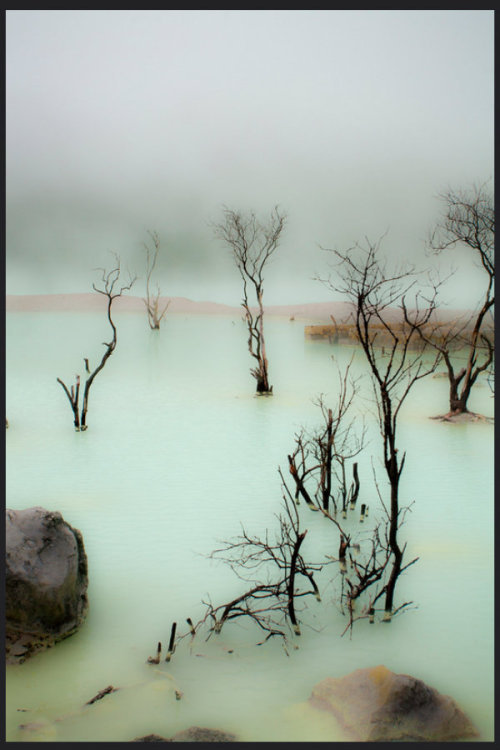
image from here
LEVEL NINE:
Imprison Within Eternal Nightmare: Whenever the Damned successfully draws a target into her private hell via Pull of Nightmare, the effect is permanent: the victim does not automatically exit the nightmare-realm when the Damned returns to the world of the living, nor does she receive any additional Willpower rolls to push herself free.
The victim may only exit the Rift when the Damned chooses to release her.
Rumors persist, of course, of powerful rescue-parties successfully invading the Rift of a Methuselah, but these tales are likely just that: mere legend.
The Damned may have a total number of prisoners caught within her Rift equal to her Humanity or Path rating.
Obscene: As Step Upon the Nightmare Bridge, above.
Manifest the Atrocity-Leviathan: The Rift of a true ancient is vast, containing multitudinous continents of horrors, hung like pulsating iridescent tumors in an ever-shifting constellation of depravity, sadism and self-hatred, laced-through with vast coils of razor-wire & city-sized shards of ichor-drenched obsidian.
Things -- unholy and undying things, born under no sane stars, armored and adorned with horrid & fleshy scribbles of frothing-mad blasphemies -- begin to breed in the shadowed places beneath that kaleidoscope of rotting, rust-caked punishment-houses. By means of this technique, such a monstrosity may be briefly loosed upon the living world.
This ability functions identically to Call Forth the Majestic Nightmare except that the entity summoned-up, rather than possessing statistics identical to the Damned, is something more terrible still.
It is left to the Storyteller’s discretion as to what terror of flesh or spirit could possibly prove more dangerous than an insane 4th-Generation vampire backed into a corner, but the Storyteller is advised to use her most wicked imagination in crafting such a cataclysm ... and not to shy away from true cosmic horror.
Obscene: As Step Upon the Nightmare Bridge, above.
Rift is an updated Discipline designed for use with Vampire: the Masquerade 20th Anniversary Edition, inspired by content from A World of Darkness (First Edition, 1992).
Brought to you absolutely free to enjoy, to test & to share – as always – by the fine folks of my Patreon.
If you enjoy this content and would like to see more dark, modern horror game-material by the author, the Bloodlines & Black Magic Kickstarter is going on right now.
Hugest of thanks to John Miętus for his invaluable editing-assistance and development during the creation of this fan-content.
#vampire the masquerade#discipline#urban#modern#horror#bloodlines and black magic#old world of darkness#v20
11 notes
·
View notes
Note
three questions: how old are you, when was the last time you bathed, and what is your religion

☯Two Lies One Truth ☯

“Way too old, what kind of question is that and Shinbutsu-shūgō.”
#✧ 𝕥𝕙𝕖𝕪 𝕔𝕒𝕝𝕝 𝕞𝕖… 𝕛𝕒𝕔𝕜 ✧ ║ ic#anon#answer#✧ 𝕞𝕪𝕤𝕥𝕖𝕣𝕚𝕠𝕦𝕤 𝕨𝕒𝕪𝕤 ✧ ║ undefined verse#{{ Jack vc: finally the meme where I can legally avoid to answer invasive questions thank u }}
1 note
·
View note
Note
Hi! You were still answering to questions about Japanese people? I have a Japanese side character in my contemporary WIP, who has moved to Europe in adult age, so I have a question about Japanese living abroad. To my knowledge both Shintoism and Buddhism are very commonly practiced in Japan? So I was just wondering, are they also common among Japanese who don't live in Japan? Or maybe just one or the other? Thank you! :)
Shintoism and Buddhism are extremely common, yes. I myself practice Shinbutsu-shūgō, a syncretism of Buddhism and Shintoism. Me and my parents live abroad in America.
There are people that may exclusively practice one or the other, but I believe that the vast majority practice Shinbutsu-shūgō. We go to both Buddhist temples and Shinto shrines for whatever is appropriate, or what we want to visit at the time. Many people have Buddhist altars and Shinto decorations in their home — my grandma has them both in her living room.
One of the really important things to understand about Shinbutsu-shūgō is that there is massive cultural significance as well. The way we practice isn’t the same as the way people from other religions tend to practice — it’s done a lot more casually, and it’s embedded into our culture. Synonymous, even. A lot of Japanese holidays have religious and cultural significance, for example. And people don’t always know if it’s religious, because it’s just something we do.
My impression of other religions such as Christianity is that it’s done a lot more formally than how we do it — this is just a personal observation however, and I don’t know if that’s a hard fact.
I’d say that there are a lot of Japanese people who are Shinbutsu-shūgō even if they don’t live in Japan. While I’m sure people may convert to other beliefs, the Buddhism/Shintoism traditions, beliefs and values are ingrained into Japanese culture, history and folklore in general. Because of this, I’d say that it’s very likely that Japanese people living outside of Japan will be a part of this religion and will continue to be, whether it’s consciously done or not, if they haven’t decided to look into and convert to other beliefs.
And like I said, it’s not a very formal method of practice so there’s often not a whole lot you have to do deliberately. Me and my family usually celebrate Hinamatsuri and New Years — but ever since I moved to college I haven’t done anything special for the former. Any other traditions are done when we’re in Japan, and it’s not particularly urgent.
API Heritage Month Q&A
#writing#writeblr#writing advice#japan#japanese culture#religion#undine answers stuff#api heritage month#japanese cultural hour#kittensartsbooks#aapi ama
36 notes
·
View notes
Text
watching a lecture on shinbutsu shūgō and cross-stitching a stardew valley project while listening to the rain
so, y'know, really livin' life on the wild side this friday night lmao
#just me#that said#my grandmother was the type to boycott disney bc pocahontas was teaching children to be 'nature worshipers'#so I feel like stardew valley's anticorporation/nature spirit leanings would freak her out#but not as much as learning about religious syncretism lmao#so maybe this IS actually rebellious in a way... hahaha#we spent some time on honji suijaku in my classes in school but it's always nice to have a refresher
11 notes
·
View notes
Text
Kōyasan 高野山 2023 Pilgrimage
Because I practice Shinbutsu Shūgō 神仏習合, I'll be sharing pics from my trip to Kōyasan, one of the most sacred sites for Shingon Buddhism. (If you don't wanna see pics or videos from this just block the tag Koyasan 2023)

It took me around 2 hours to go from Kyoto city out to Wakayama prefecture by local/express trains. But it was worth it to see the beautiful scenery.
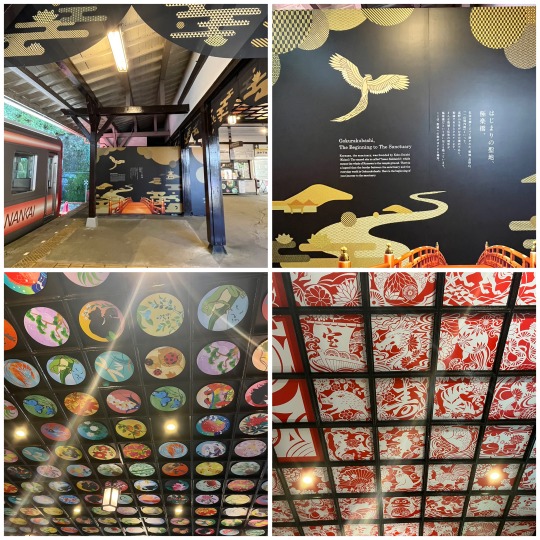
Getting to the official first stop for Kōyasan let me off in an absolutely stunning train station with a lot of beautiful artwork in the ceilings, and reminded me of lacquer paintings.
Even the trains had stunning artwork. In order to get up the mountain you take a cable car, then once you're there you take a bus to the town.


I got a video of the ascent to the top
1 note
·
View note